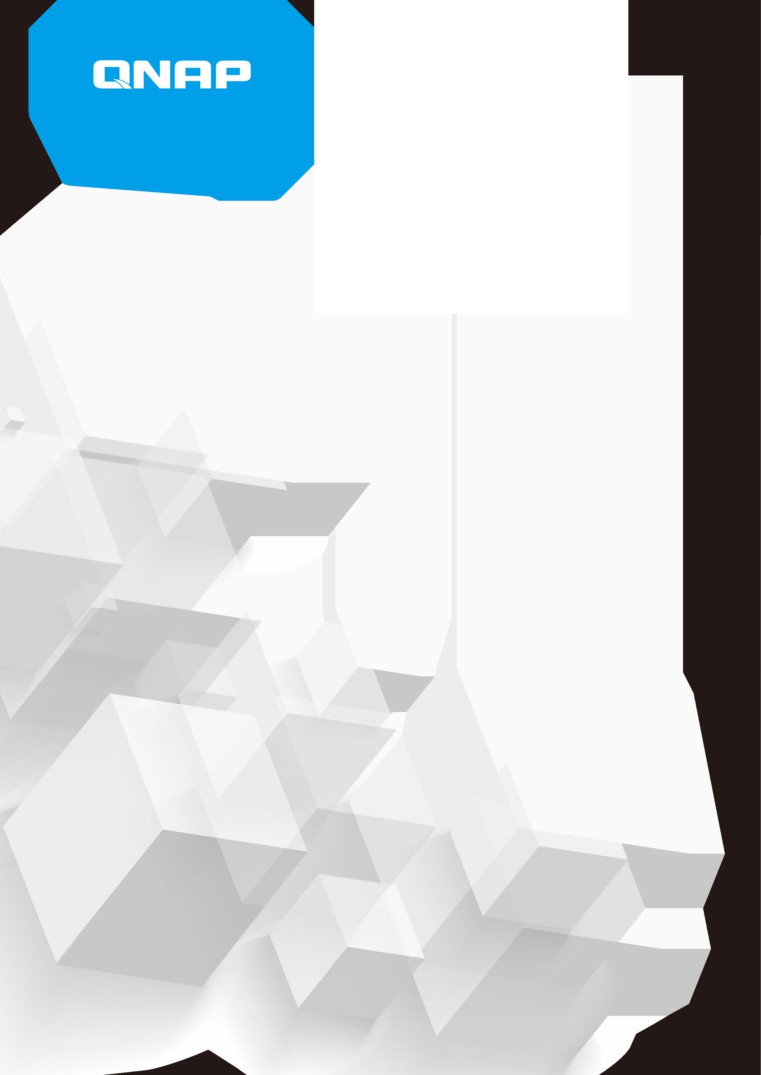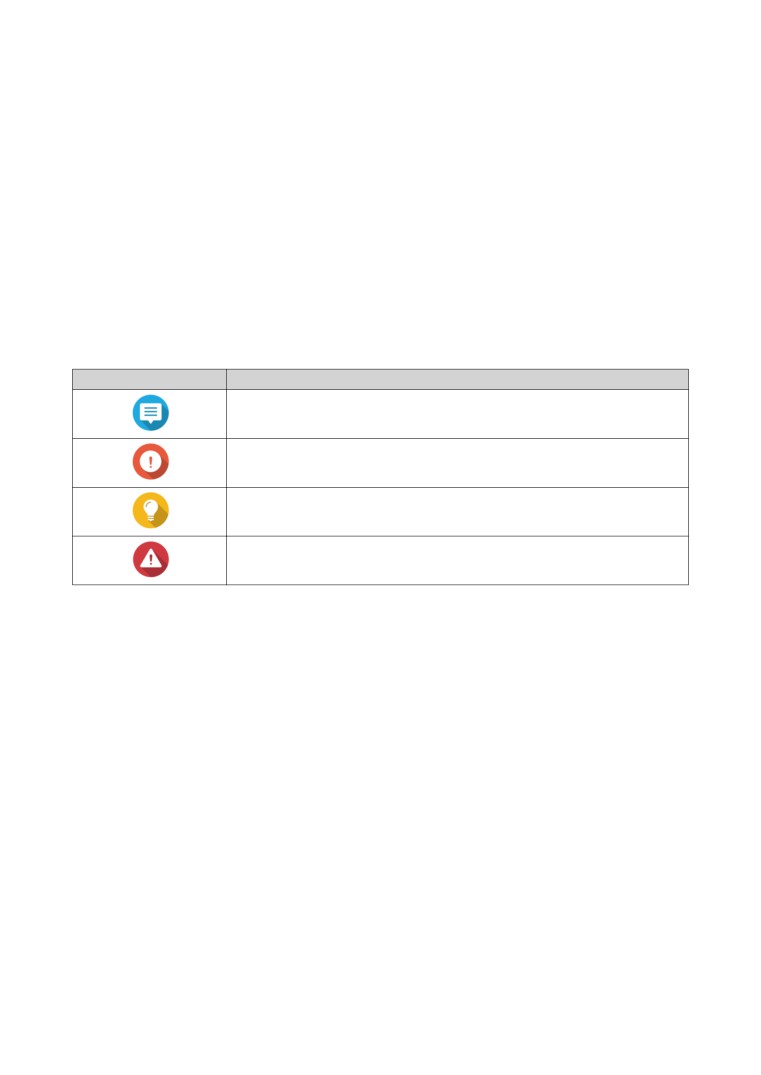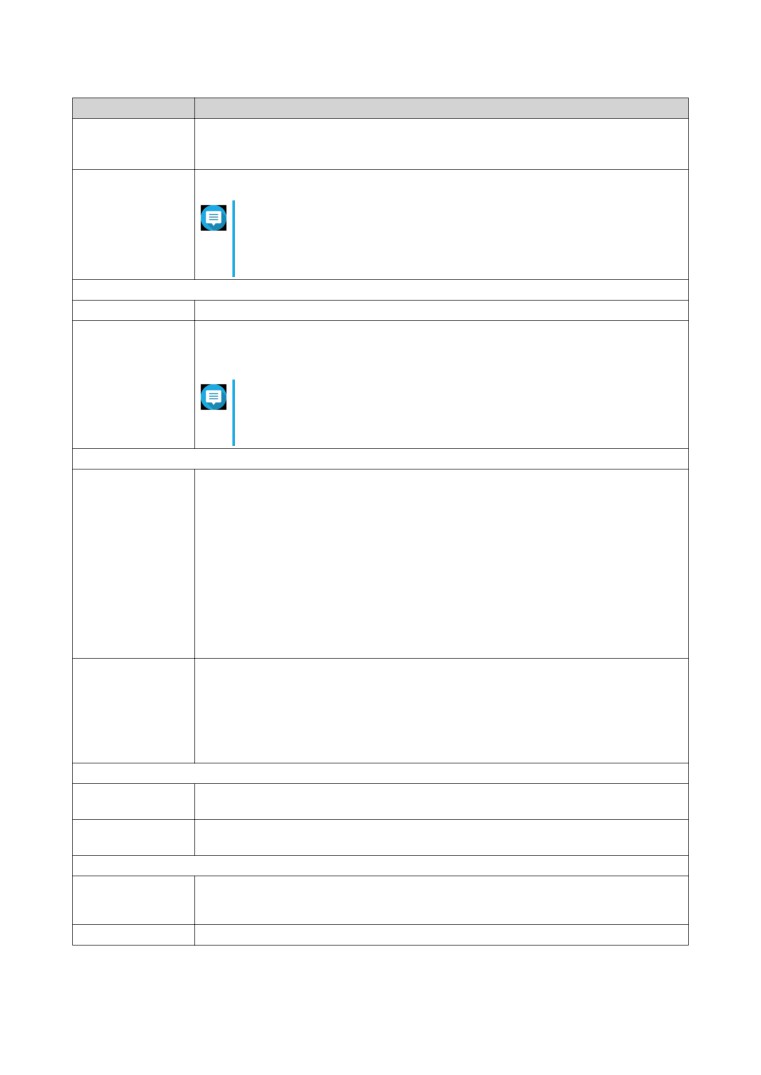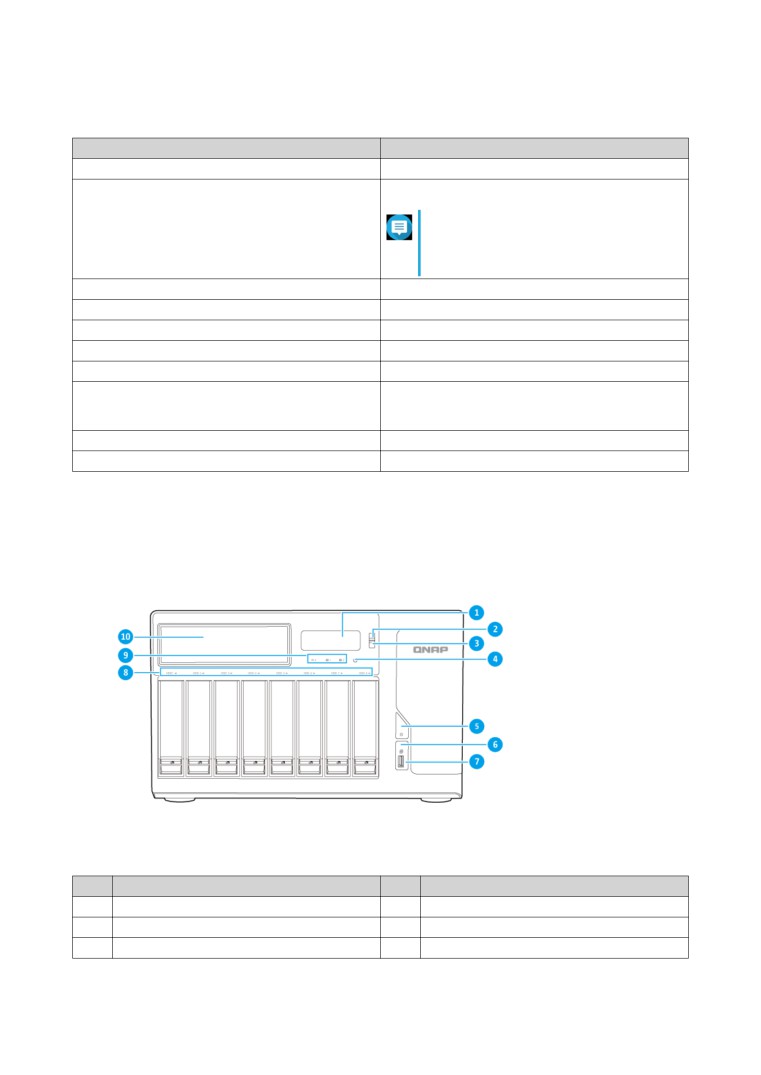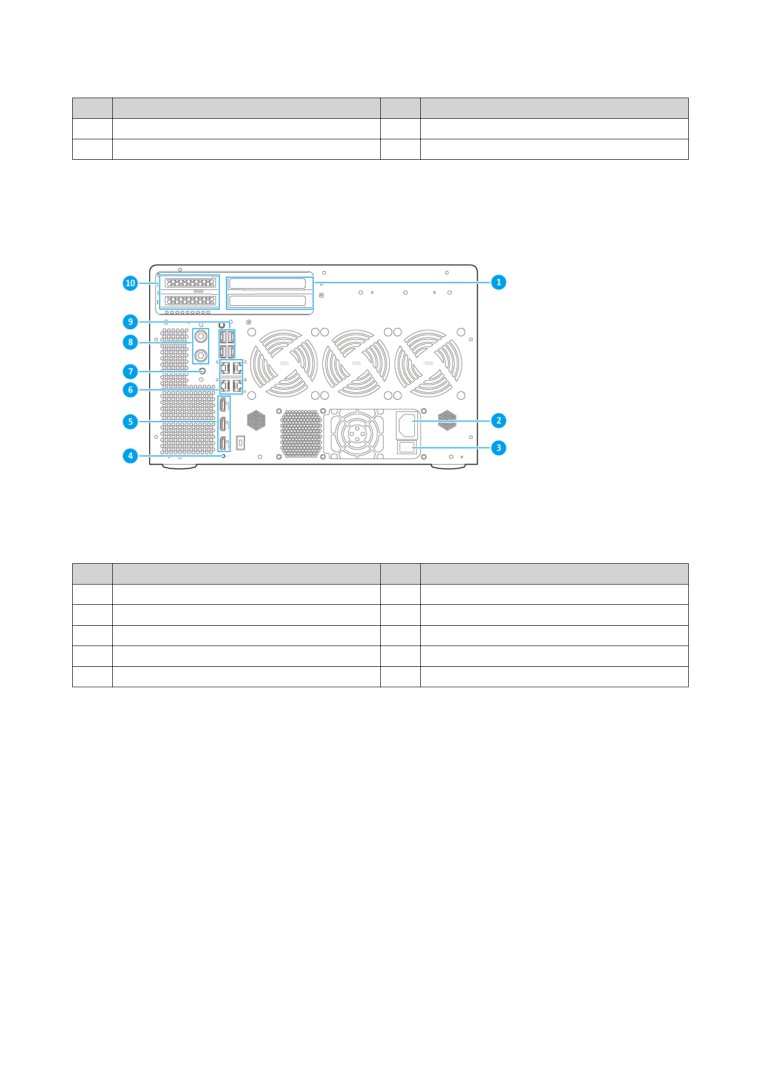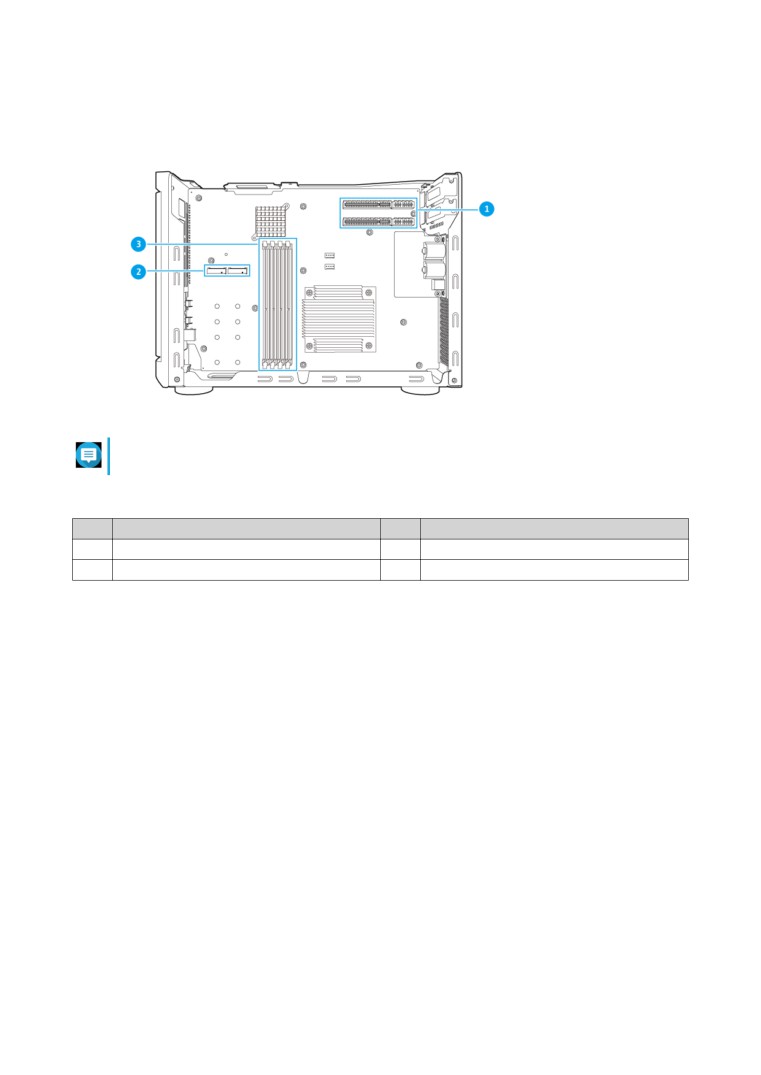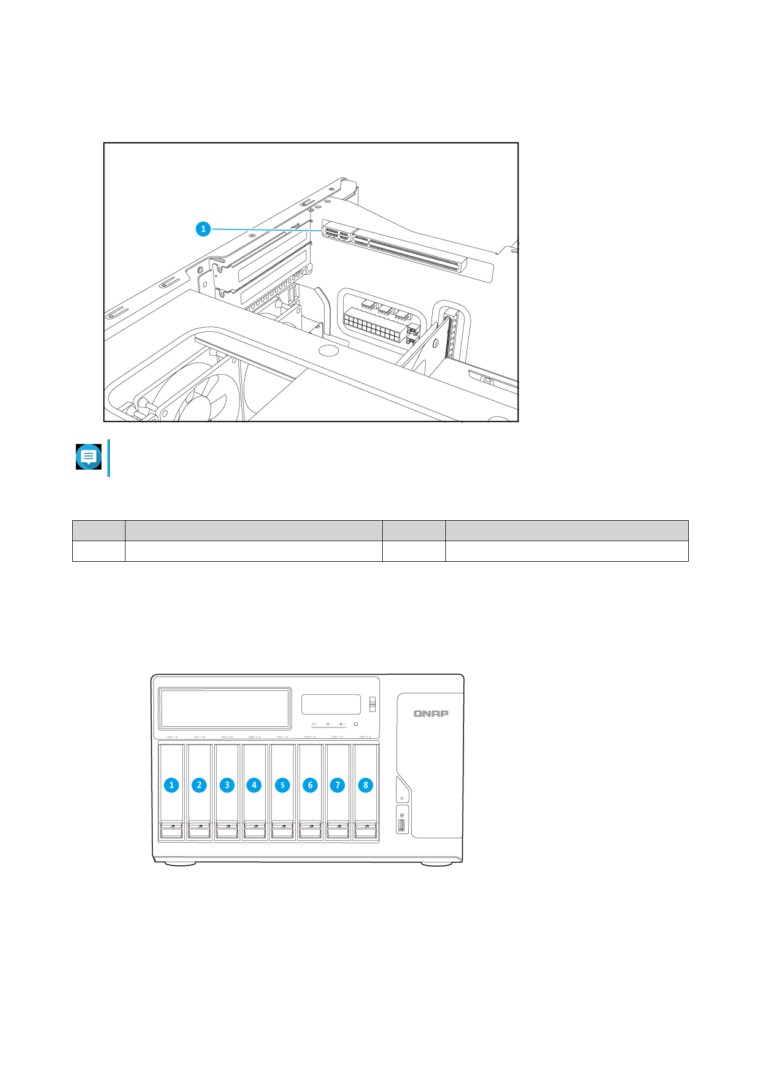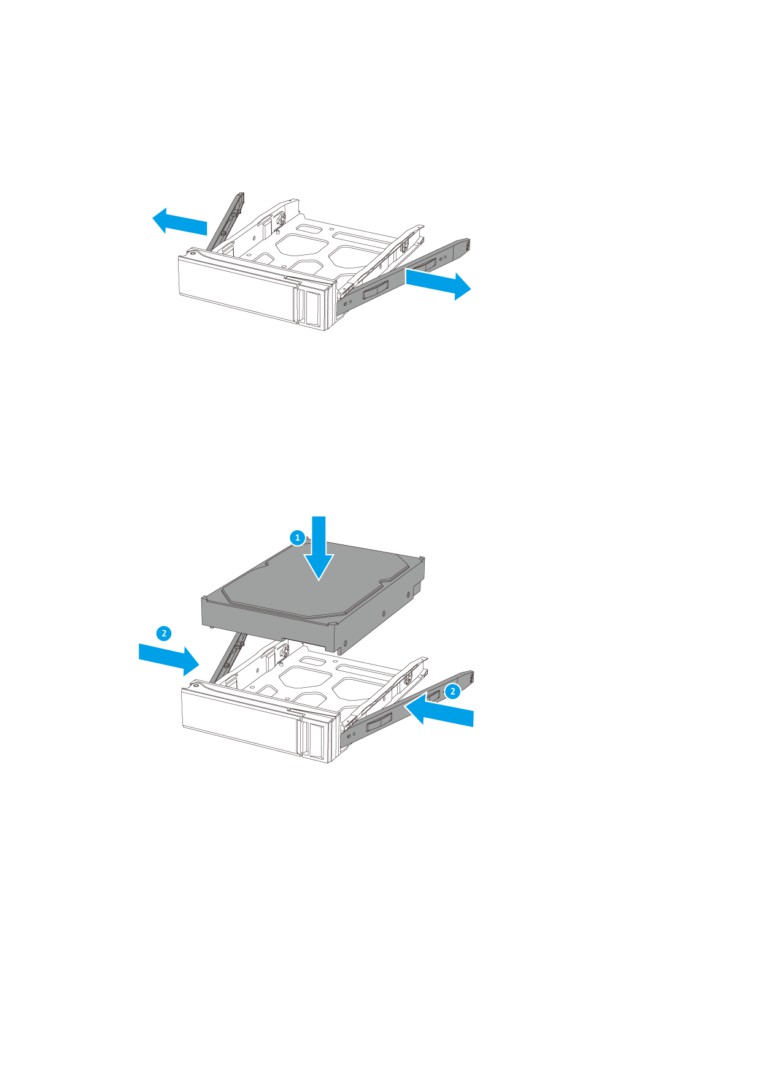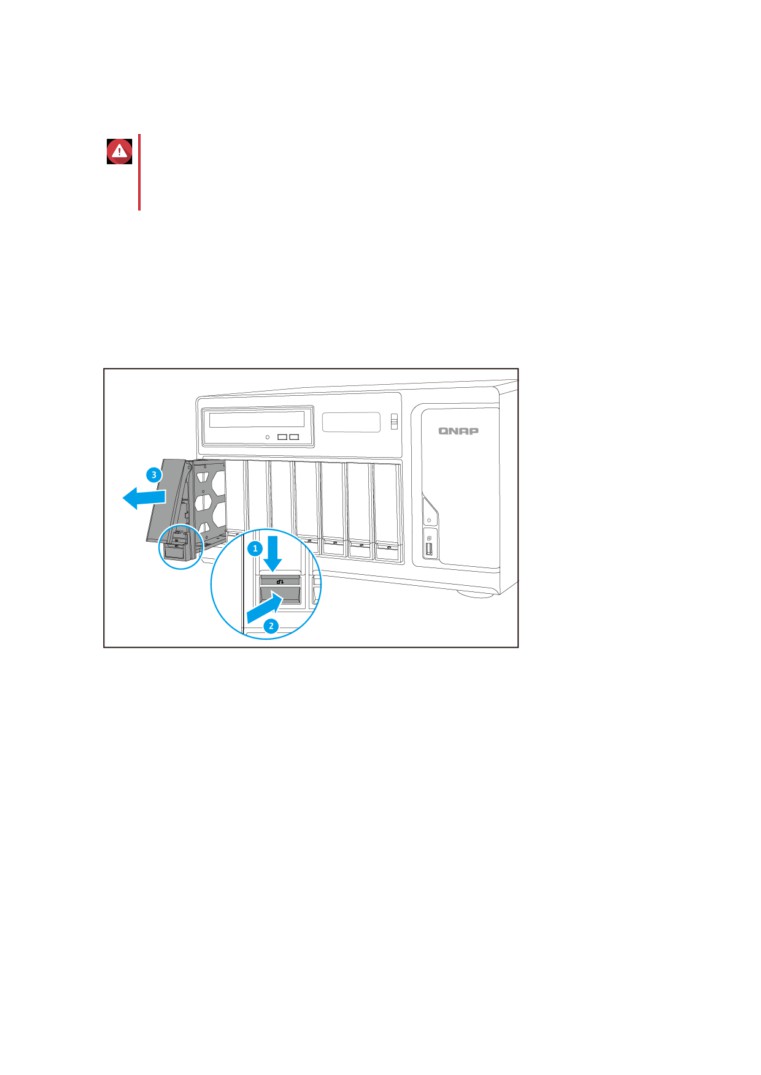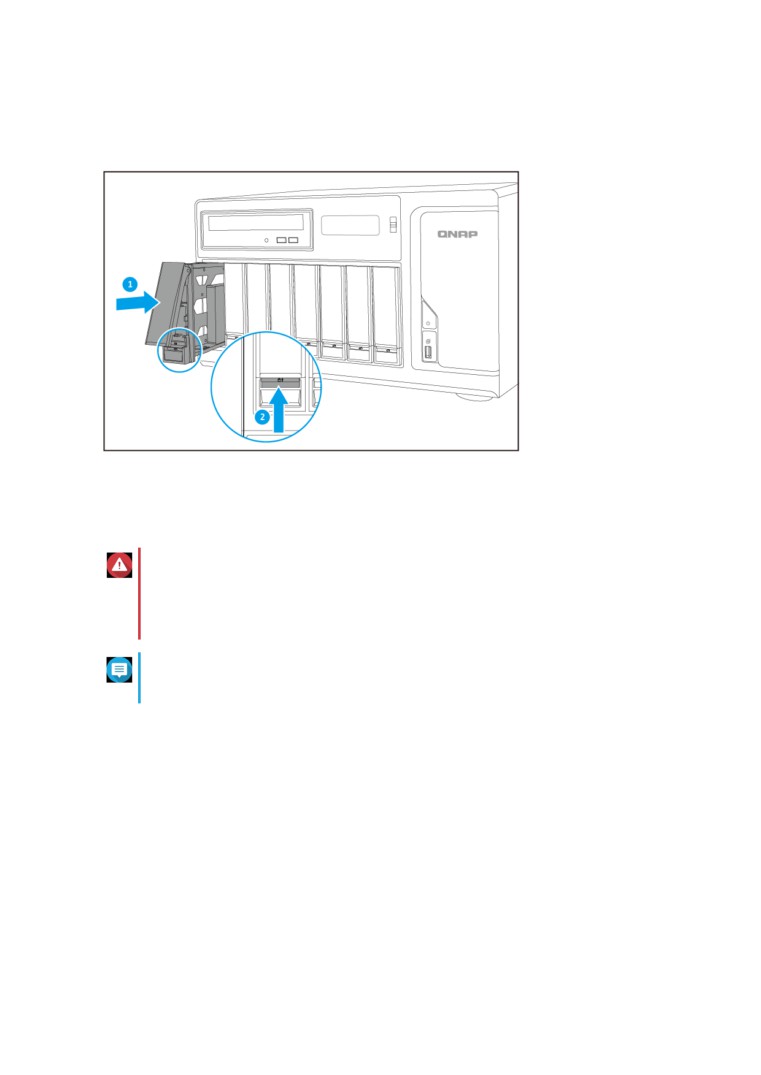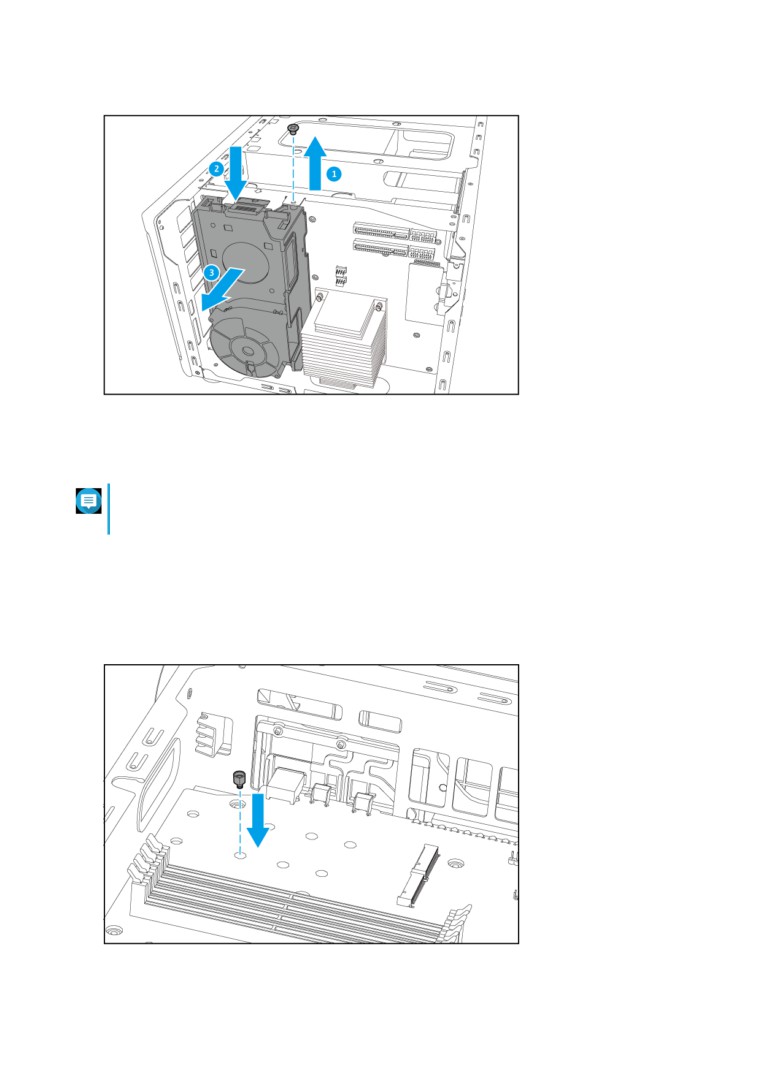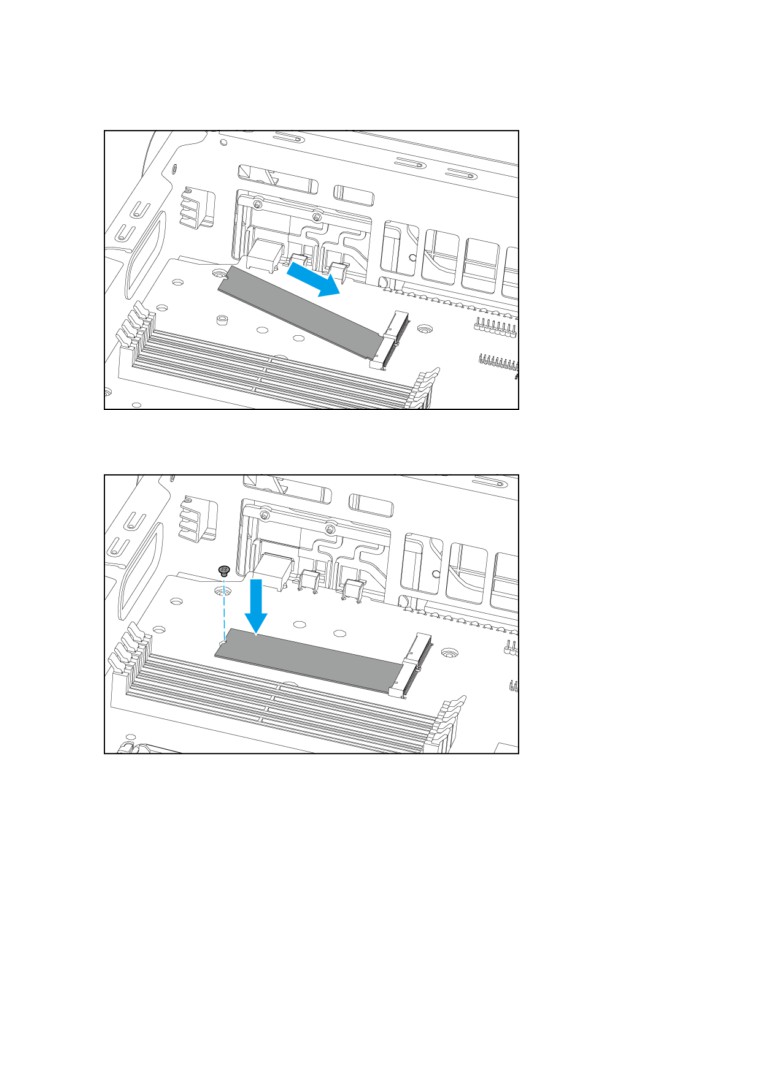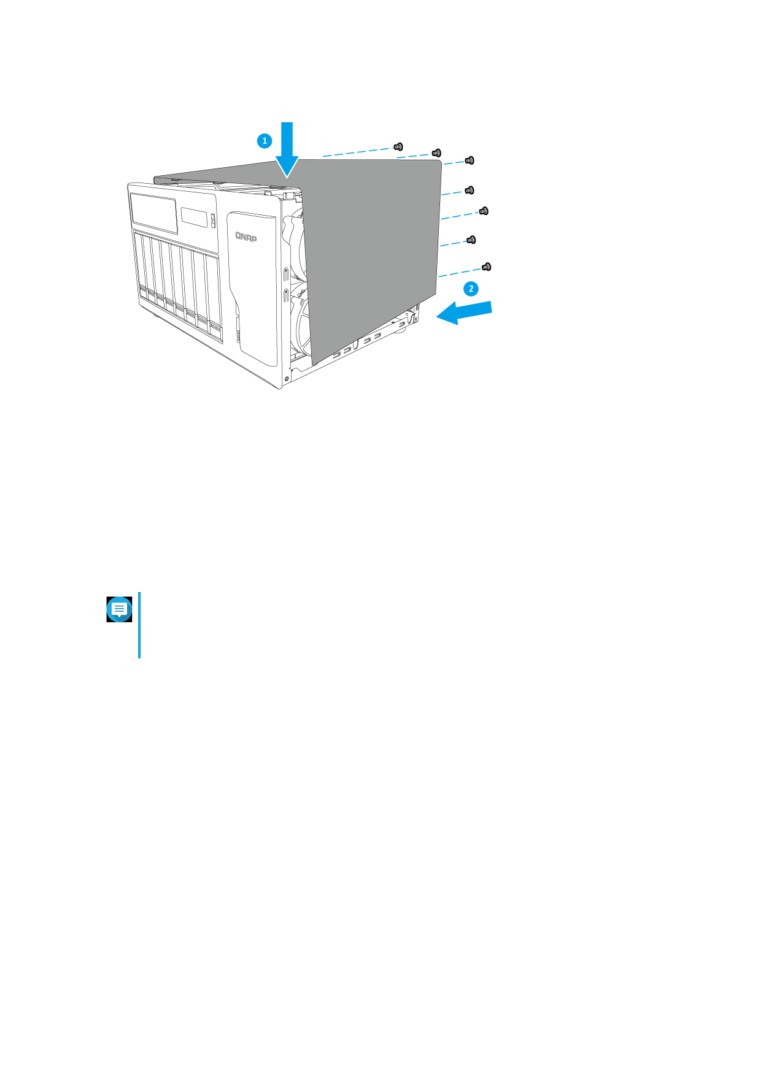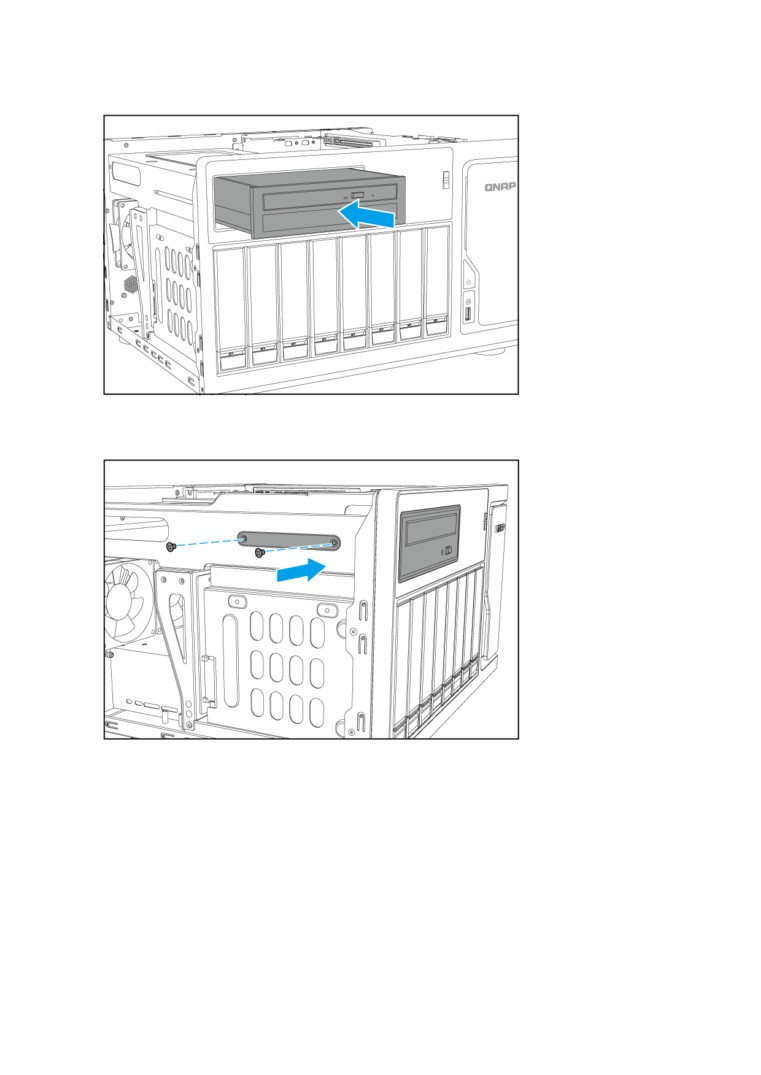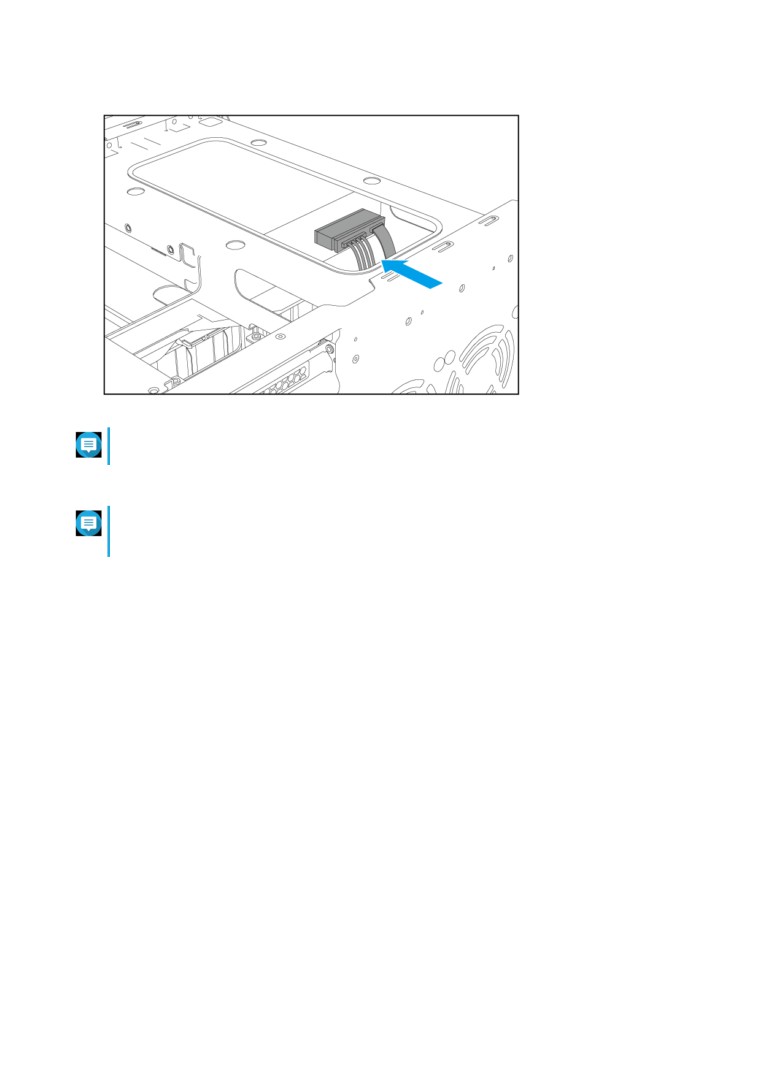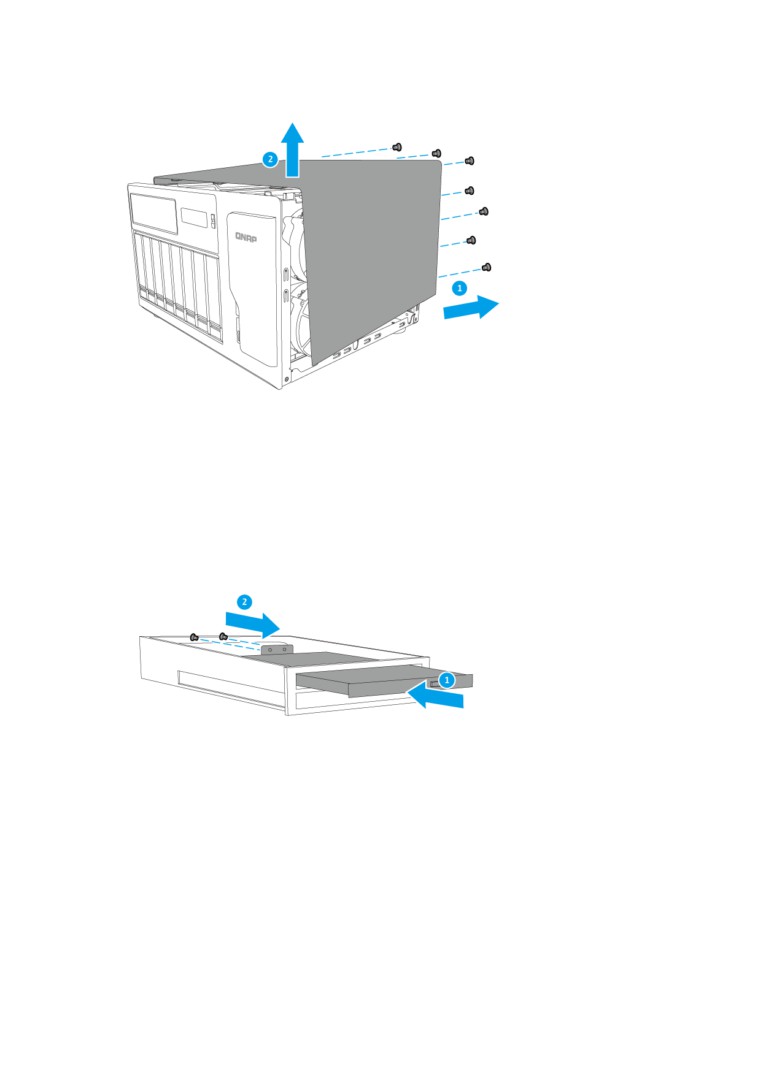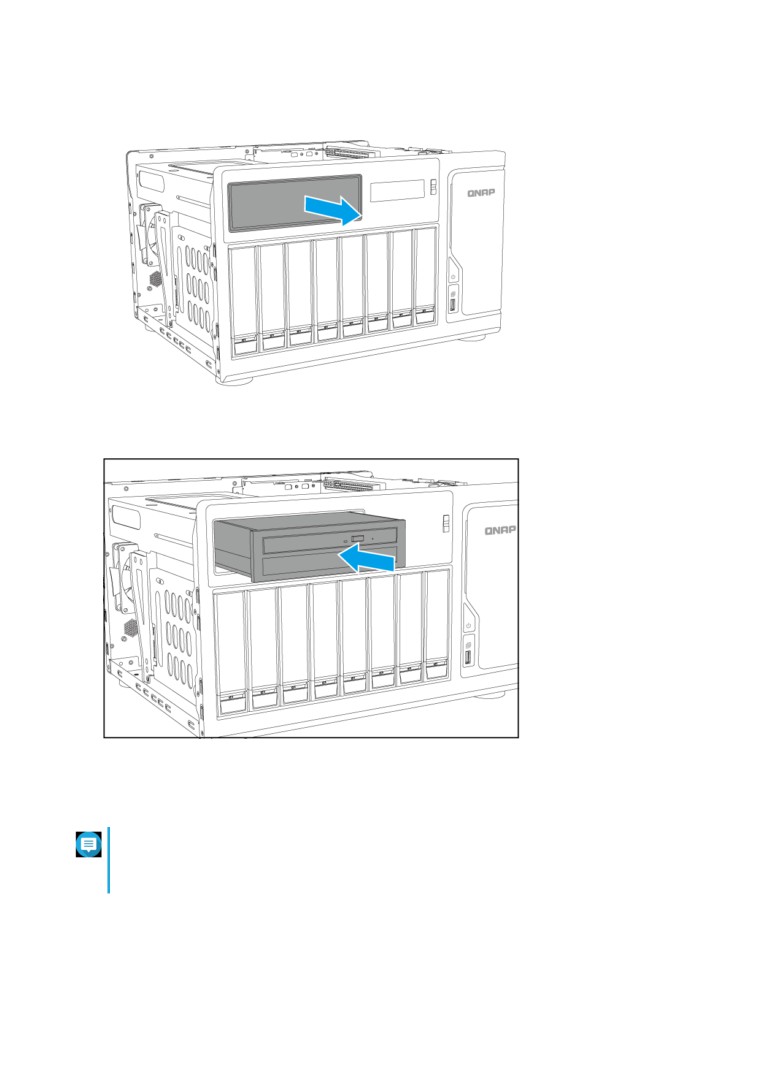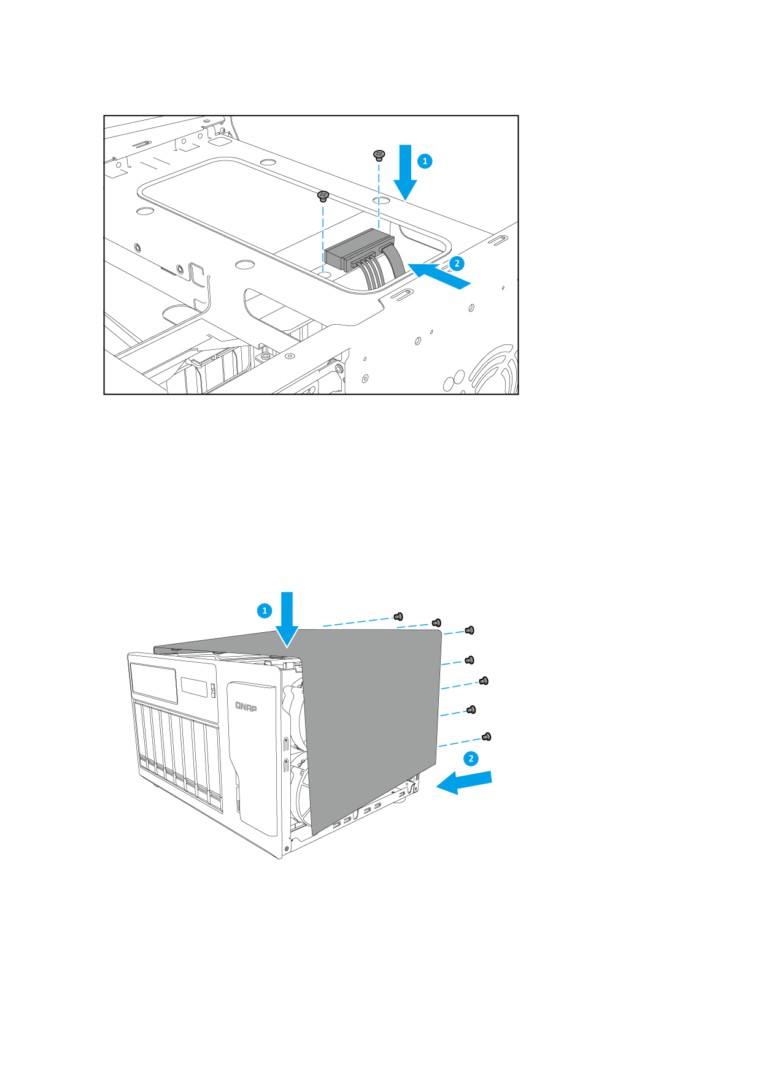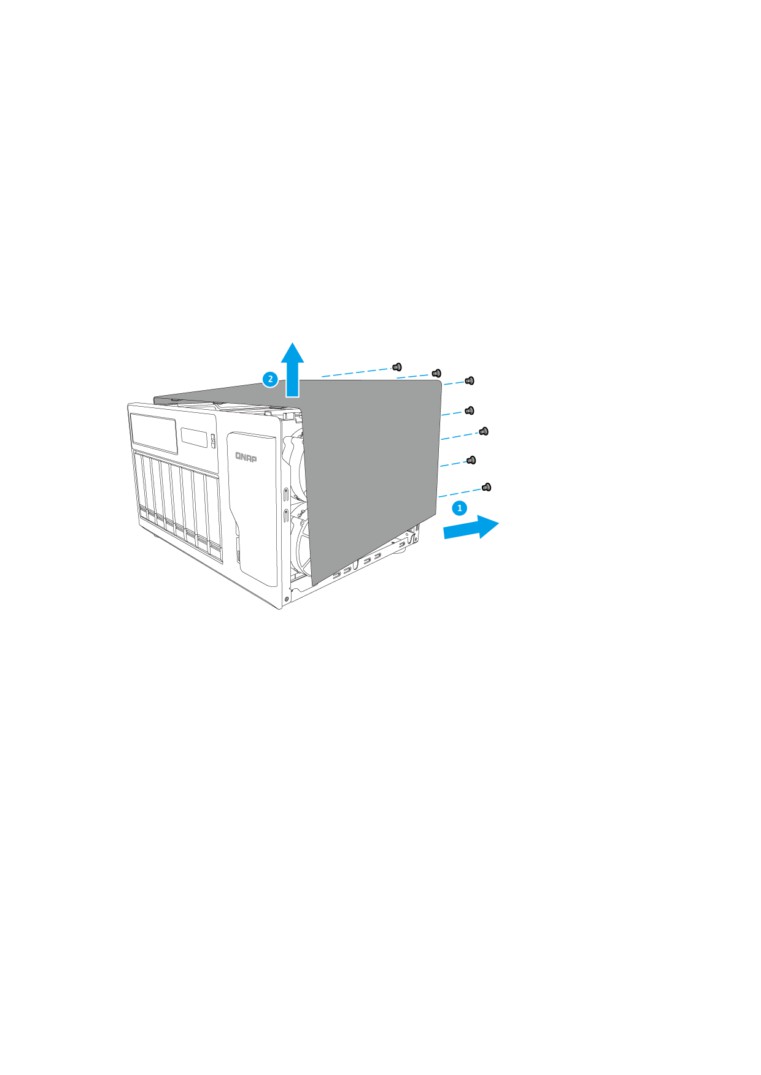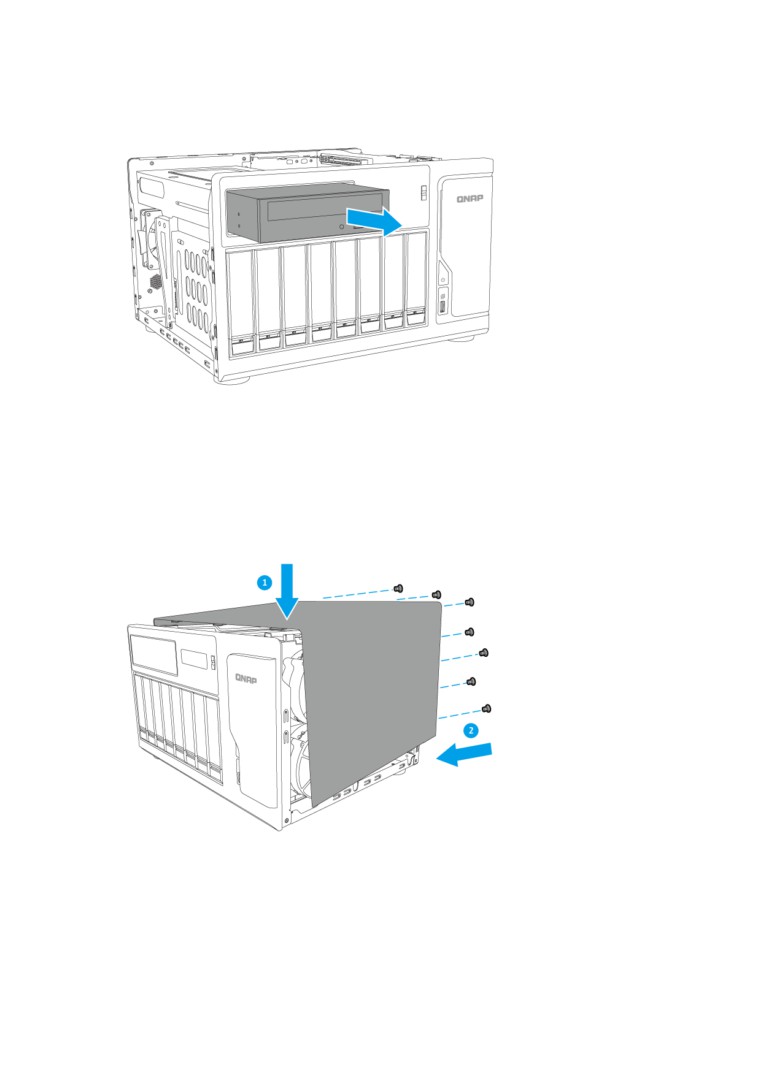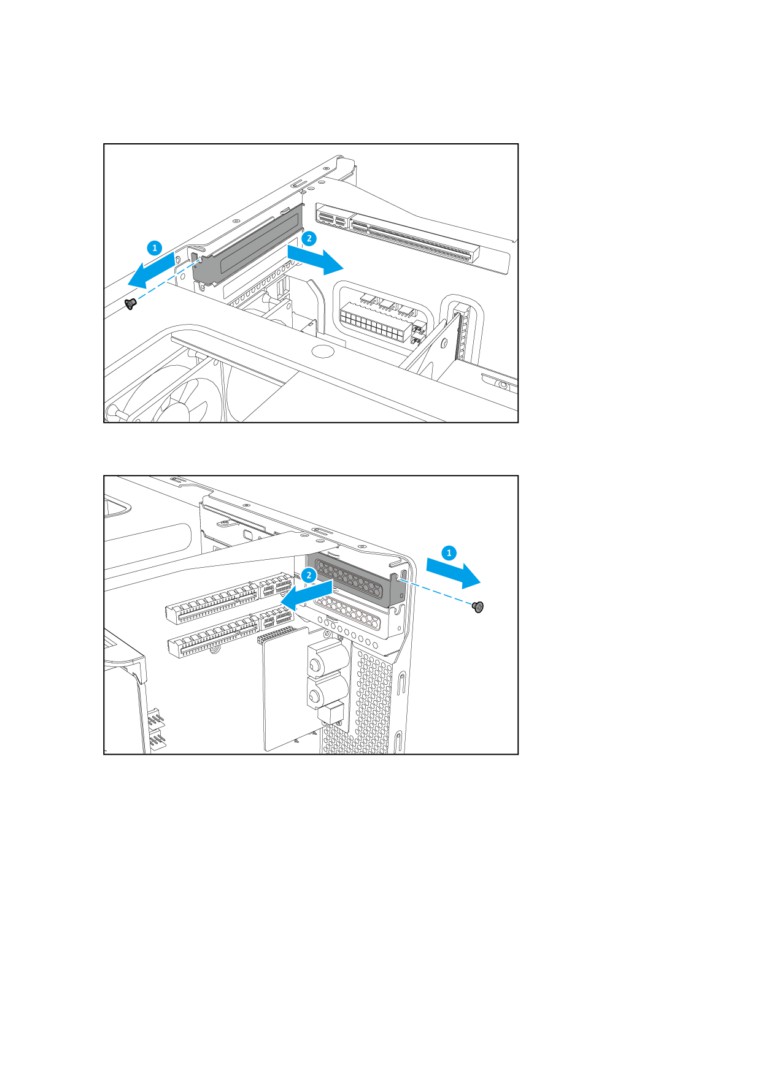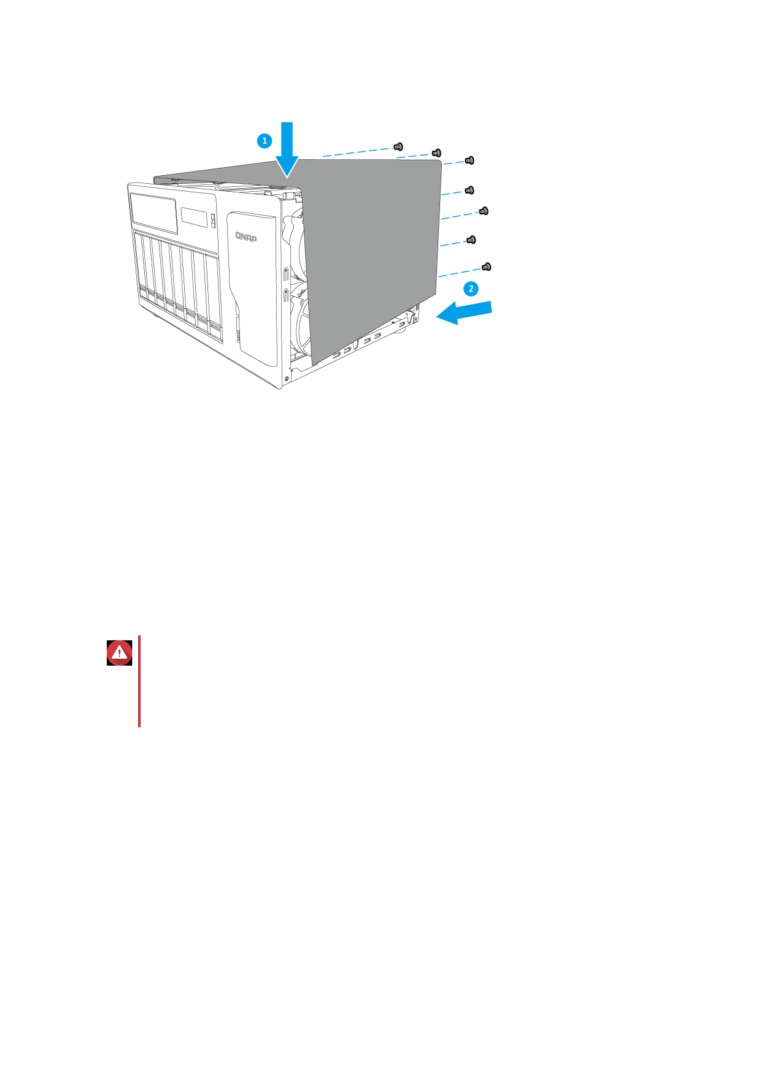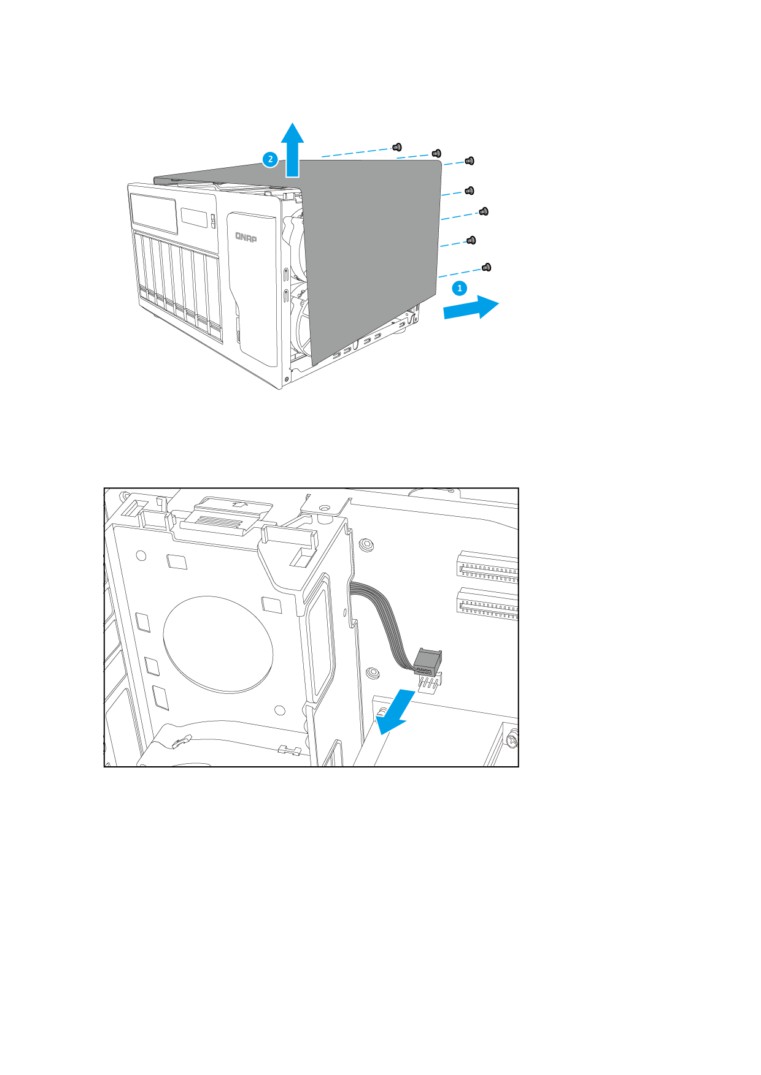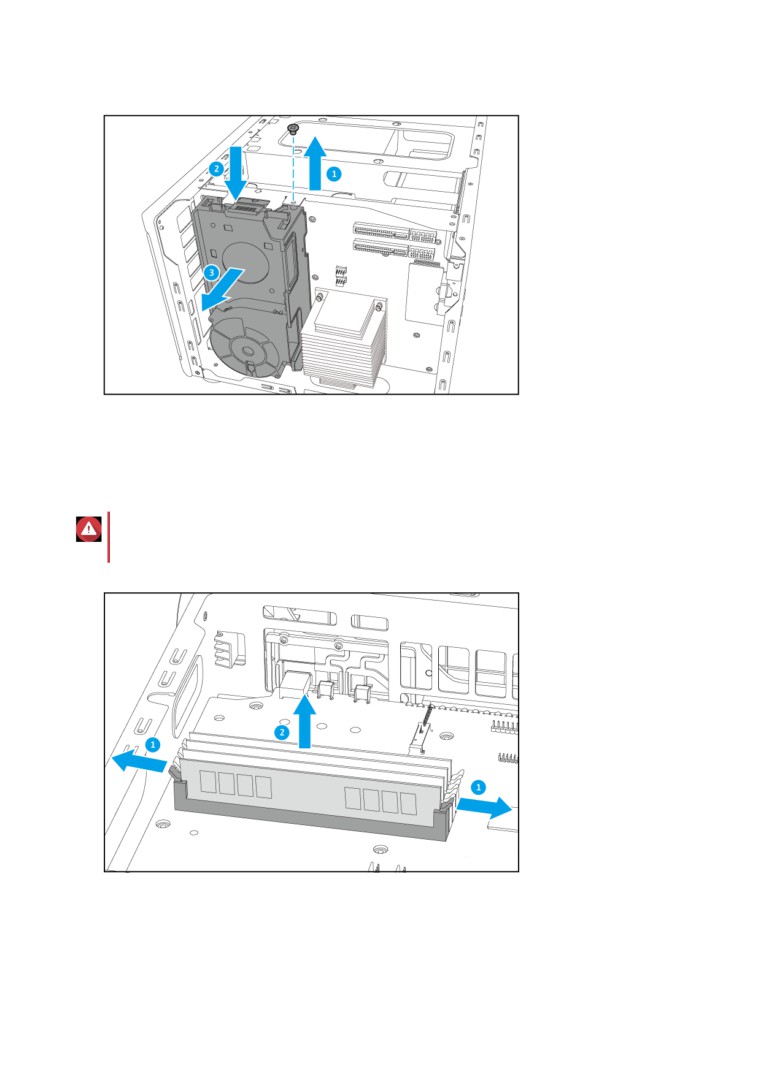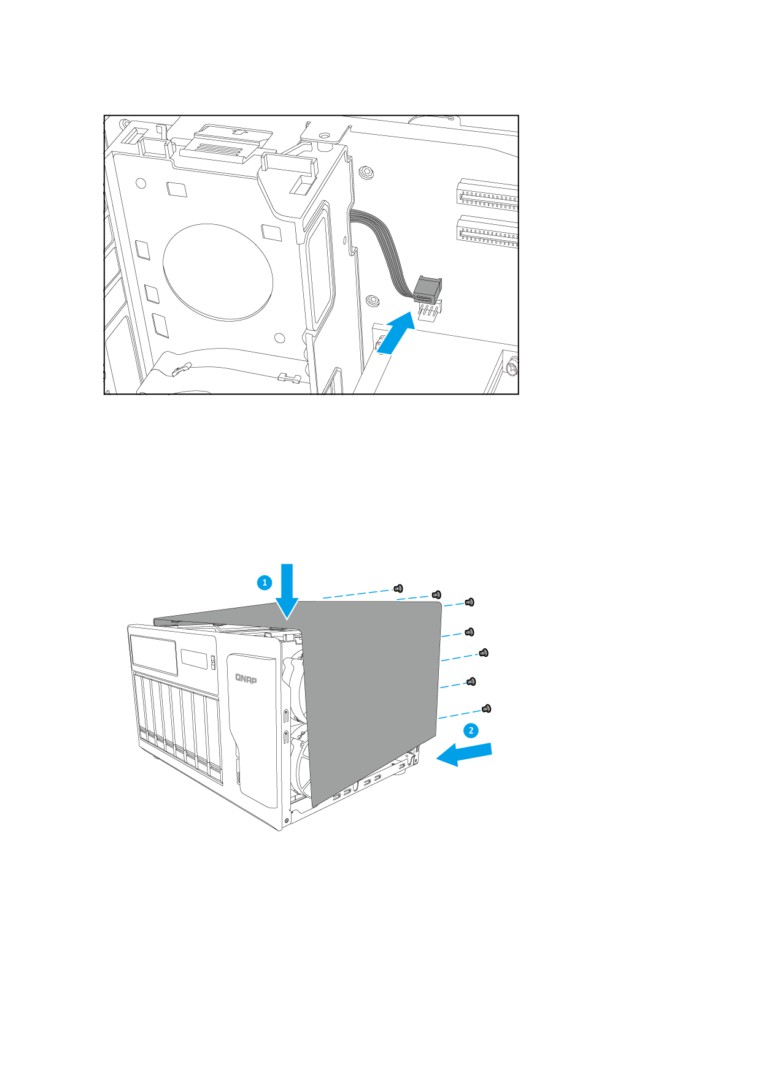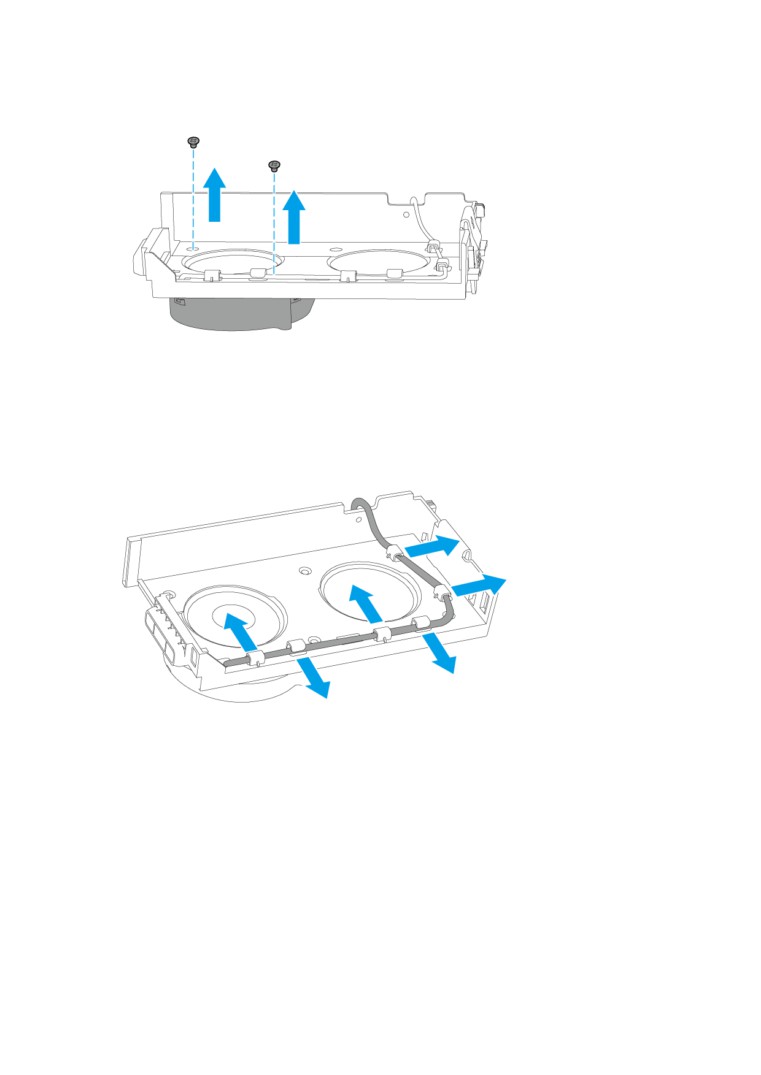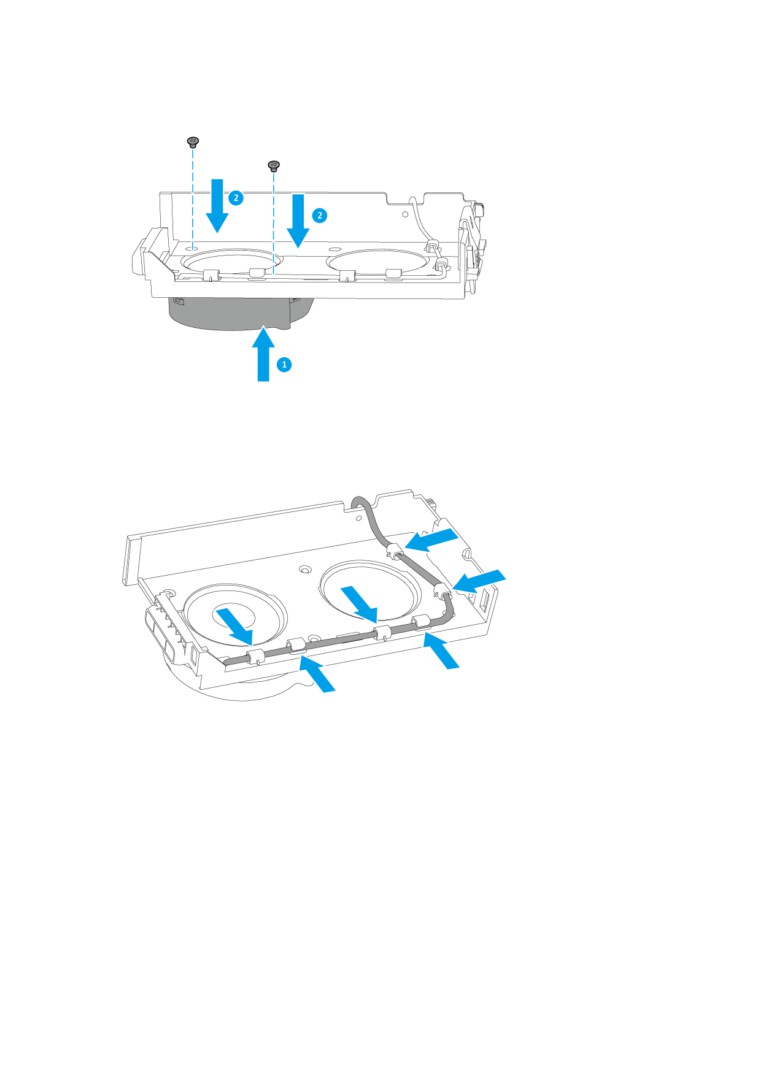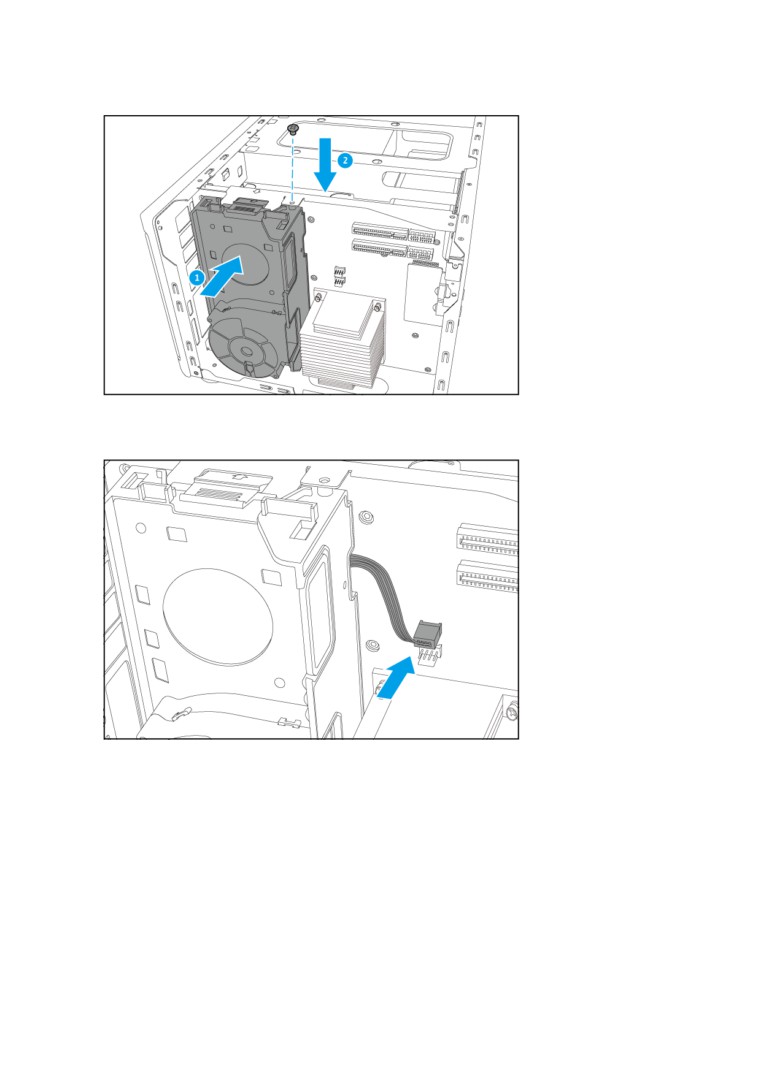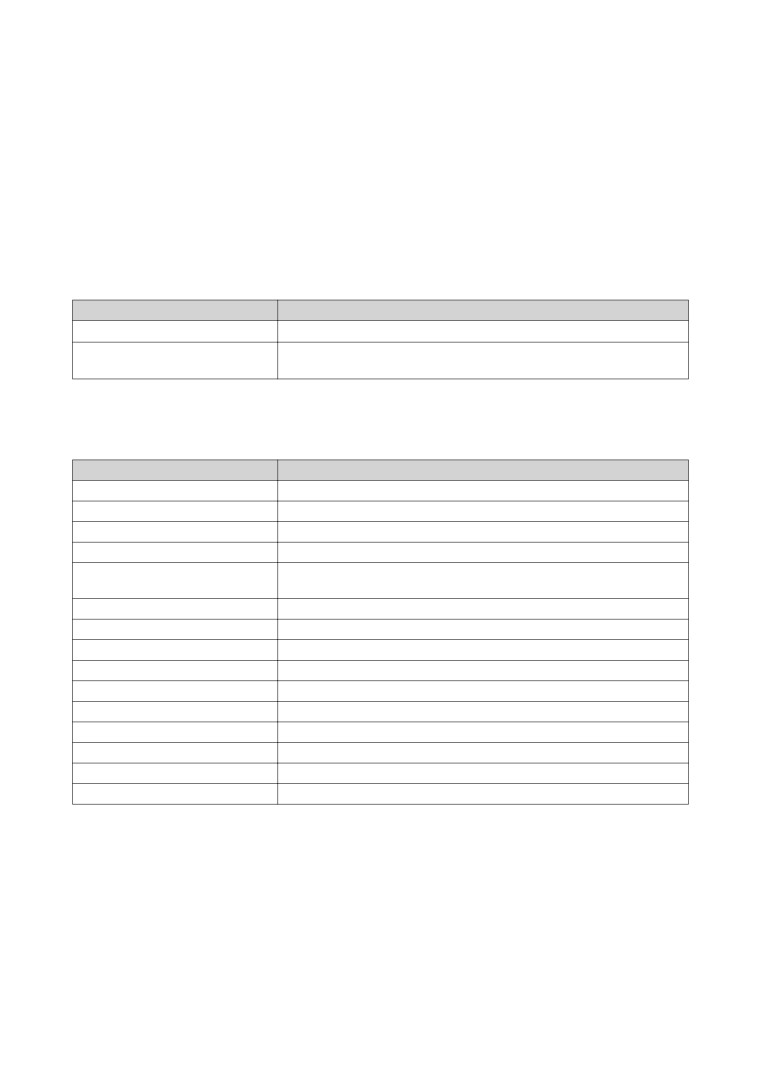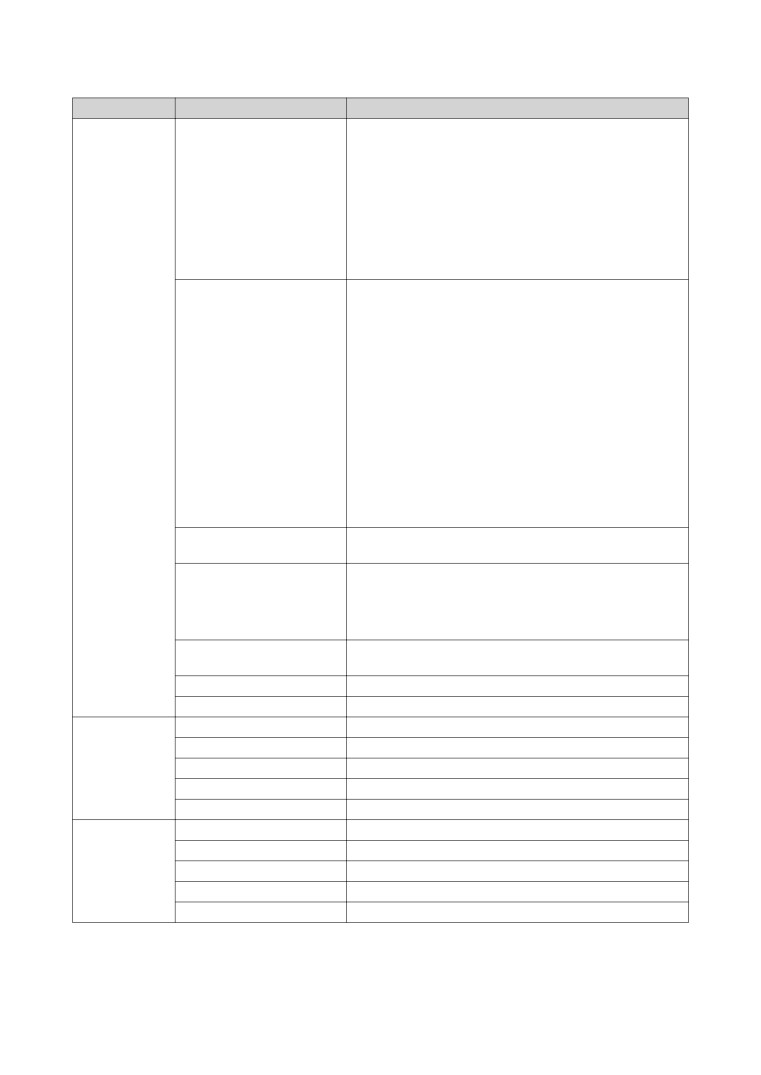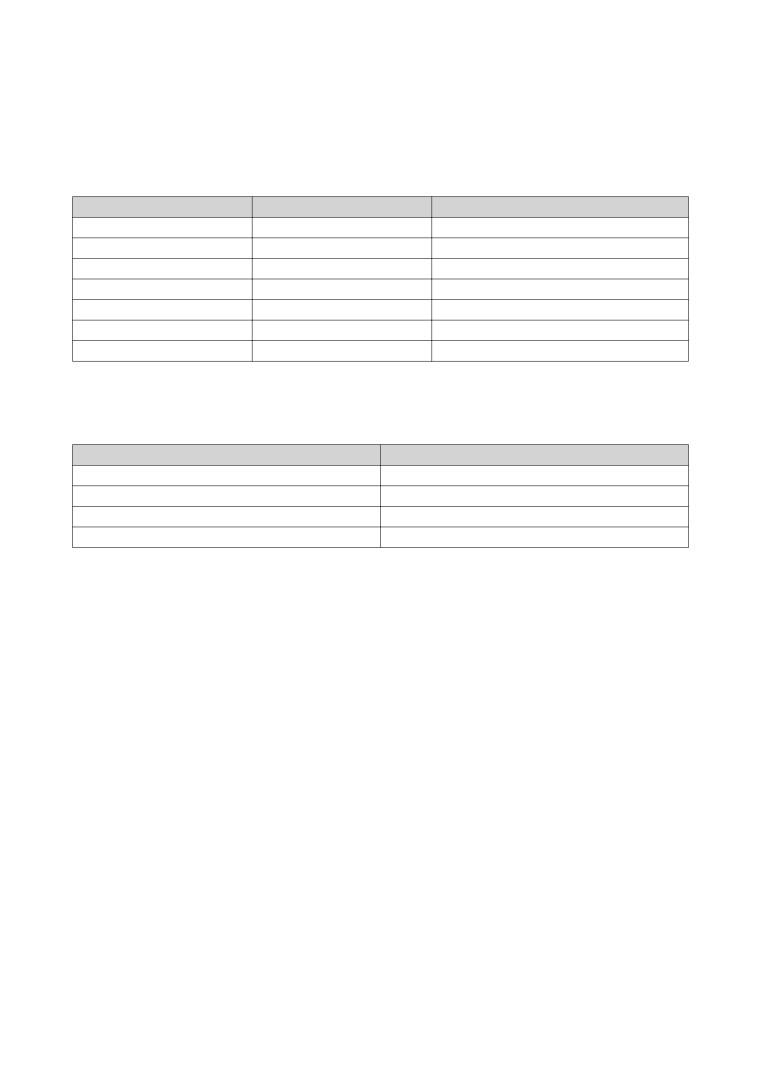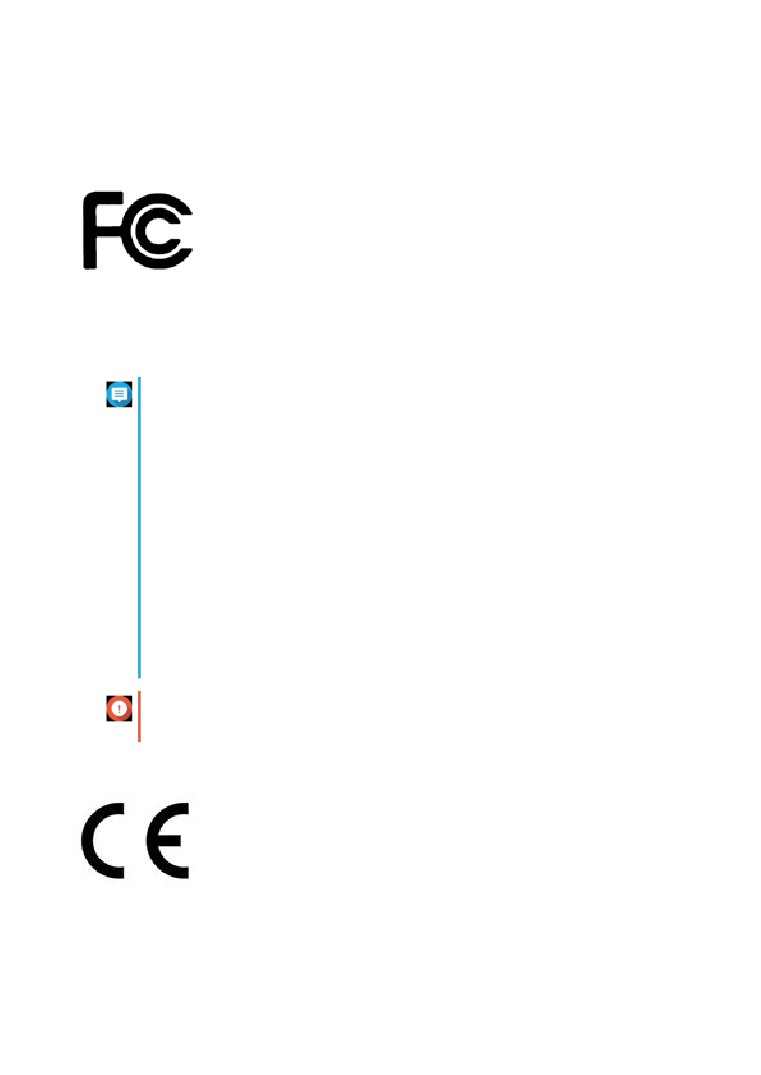TVS-882BR
User Guide
Document Version: 2
13/07/2017
TVS-882BR User Guide
Contents
1. Preface
About This Guide
3
Audience
3
Document Conventions
3
2. Product Overview
About the TVS-882BR
4
Hardware Specifications
4
Package Contents
7
Components
7
Front Panel
7
Back Panel
8
Right Panel
9
Left Panel
10
Drive Numbering
10
M.2 Solid State Drive Numbering
11
Installation Requirements
11
Setting Up the NAS
11
3. Installation and Configuration
Hardware Installation
13
Drive Installation
13
Optical Drive Installation
23
Installing Expansion Cards
35
Replacing Memory Modules
39
Replacing CPU Fans
44
QTS Installation
49
Installing QTS Using Qfinder Pro
50
Installing QTS Using the Cloud Key
51
Installing QTS Using an HDMI Connection
53
4. Basic Operations
Power Button
54
Reset Button
54
USB One-Touch Copy Button
54
LCD Panel
55
Viewing TCP/IP Settings
55
Configuring TCP/IP Settings
55
Viewing Drive Information
56
Viewing Volume Information
56
Viewing System Information
57
Powering Off the NAS
57
Restarting the NAS
57
Changing the LCD Password
57
LCD Error Messages
58
LEDs
58
Beep Alarm
60
5. Troubleshooting
Forcing Qfinder Pro or myQNAPcloud to Locate the NAS
61
1
Hot-Swapping Failed Drives
61
Recovering Unintentionally Removed Healthy Drives
62
Support and Other Resources
62
6. Glossary
CloudKey
63
CloudLink
63
myQNAPcloud
63
myQNAPcloud ID
63
Qfinder Pro
63
QTS
63
7. Notices
Limited Warranty
64
Disclaimer
64
GNU Public License
64
FCC Notice
72
CE Notice
72
SJ/T 11364-2006
73
2
TVS-882BR User Guide
1. Preface
About This Guide
This guide provides information on the QNAP TVS-882BR NAS and step-by-step instructions on installing
the hardware. It also provides instructions on basic operations and troubleshooting information.
Audience
This document is intended for consumers and storage administrators. This guide assumes that the user has
a basic understanding of storage and backup concepts.
Document Conventions
Symbol
Description
Notes provide default configuration settings and other supplementary
information.
Important notes provide information on required configuration settings and other
critical information.
Tips provide recommendations or alternative methods of performing a task or
configuring settings.
Warnings provide information, that when ignored, may result to potential loss,
injury, or even death.
Preface
3
TVS-882BR User Guide
2. Product Overview
This chapter provides basic information about the QNAP TVS-882BR NAS.
About the TVS-882BR
The TVS-882BR is powered by 7th generation Intel® quad-core processors and dual-channel DDR4 RAM.
The NAS includes one 5.25-inch SATA drive bay for Blu-ray disc drive installation. The TVS-882BR also has
two M.2 SSD slots for cache acceleration, three HDMI ports for media applications, and three PCIe 3.0 slots
for various expansion options.
Hardware Specifications
Important
Modifying the hardware or software of your QNAP product invalidates the warranty. QNAP
is not responsible for any damage or data loss caused by unauthorized modifications and
installation of unsupported third-party applications.
Component
TVS-882BR
Ordering P/N
• TVS-882BR-i5-16G
• TVS-882BR-i7-32G
• TVS-882BR-ODD-i5-16G
• TVS-882BR-ODD-i7-32G
Processor
CPU
Intel® Core™ i5-7500 quad-core
Intel® Core™ i7-7700 quad-core 3.6 GHz, burst
3.4 GHz, burst up to 3.8 GHz
up to 4.2 GHz
Architecture
64-bit
Graphics
9th generation Intel® HD Graphics
Memory
Pre-installed
16 GB (2 x 8 GB) of DDR4 UDIMM
32 GB (4 x 8 GB) of DDR4 UDIMM
memory
Total memory slots
4
Maximum memory
64 GB (4 x 16 GB)
Storage
Drive bays
8 x SATA 6 Gbps
Drive compatibility
•
3.5-inch SATA hard disk drives
•
2.5-inch SATA hard disk drives
•
2.5-inch SATA solid state drives
M.2 SSD interface
2 x SATA 6 Gbps
type
M.2 SSD
•
2242
compatibility
•
2260
•
2280
•
22110
Product Overview
4
TVS-882BR User Guide
Component
TVS-882BR
SSD cache
• Drives 1 to 8
acceleration
support
• M.2 SSDs 1 to 2
Hot-swappable
Yes
Note
• SSD cache drives are not hot-swappable.
• M.2 SSDs are not hot-swappable.
Optical Storage
Optical drive bay
1 x 5.25-inch SATA
Optical drive type
•
1 x 5.25-inch Blu-ray Disc drive
•
2 x Slim optical drives
Note
The TVS-882BR-ODD-i5-16G and TVS-882BR-ODD-i7-32G
include a pre-installed 5.25-inch Blu-ray Disc writer. For other NAS
models, optical drives must be purchased separately.
RAID
RAID types
•
Single
•
JBOD
•
RAID 0
•
RAID 1
•
RAID 5
•
RAID 6
•
RAID 10
RAID Migration
•
Single to RAID 1
•
Single to RAID 5
•
RAID 1 to RAID 5
•
RAID 5 to RAID 6
Network
10 Gigabit Ethernet
Optional: 10GbE port through a PCIe expansion card
ports
Gigabit Ethernet
4 x RJ45
ports
Expansion
USB ports
•
Front: 1 x USB 3.0
•
Rear: 4 x USB 3.0
Thunderbolt™
N/A
Product Overview
5
TVS-882BR User Guide
Component
TVS-882BR
PCIe slots
•
1 x PCIe 3.0 x8
•
2 x PCIe 3.0 x4
Audiovisual
LCD Panel
Monochrome LCD with Enter & Select buttons
HDMI outputs
3 x HDMI v1.4b ports (up to 3840 x 2160 @ 30 Hz resolution)
Audio
•
2 x 6.3 mm microphone jacks
•
1 x 3.5 mm line-out jack
•
2 x built-in speakers
Interface
Buttons
•
Power
•
USB One Touch Copy
•
Reset
LED indicators
•
Status
•
Drives 1 to 8
•
M.2 SSDs 1-2
IR sensor
QNAP RM-IR004 remote control (MCE compatible)
Dimensions
Dimensions (H x W
234.6 x 369.9 x 319.8 mm
x D)
9.23 x 14.56 x 12.59 in
Net weight
•
NAS: 11.55 kg (25.46 lbs)
•
5.25-inch optical drive: 0.63kg (1.39 lbs)
Form factor
Tower
Other
Flash memory
512 MB DOM
Power supply unit
ATX 100-240 V, 3-1.5 V Output 250 W
Fans
•
System: 3 x 80 mm
•
CPU: 1 x 90 mm
Sound level
Sound pressure (LpAm) (bystander position): 21.6 dB
(with 8 x Seagate ST2000VN000-1HJ164 hard drive installed)
Operating
0 to 40˚C (32 to 104˚F)
temperature
Relative humidity
•
Non-condensing relative humidity: 5 to 95%
•
Wet-bulb temperature: 27˚C (80.6˚F)
Note
Model specifications are subject to change without prior notice. To see the latest
Product Overview
6
TVS-882BR User Guide
Package Contents
Item
Quantity
TVS-882BR NAS
1
5.25-inch Blu-ray Disc drive
1
Note
The TVS-882BR-ODD-i5-16G and
TVS-882BR-ODD-i7-32G include a pre-
installed 5.25-inch Blu-ray Disc writer.
Power cord
1
Ethernet cables
4
RM-IR004 infrared (IR) remote control
1
Screws for 3.5-inch drives
32
Screws for 2.5-inch drives
24
Screws for M.2 solid state drives
•
2 x flat head screws
•
2 x riser screws
M.2 SSD heatsinks
2
Quick Installation Guide (QIG)
1
Components
Front Panel
No.
Component
No.
Component
1
LCD panel
6
USB One Touch Copy button
2
Enter button
7
USB 3.0 One Touch Copy port
3
Select button
8
Drive LEDs
Product Overview
7
TVS-882BR User Guide
No.
Component
No.
Component
4
Status LED
9
M.2 LEDs
5
Power button
10
Optical drive bay
Back Panel
No.
Component
No.
Component
1
PCIe 3.0 x8 cover
6
Gigabit RJ45 Ethernet ports
2
Power port
7
3.5 mm speaker jack
3
Power switch
8
6.3 mm microphone jacks
4
Reset button
9
USB 3.0 ports
5
HDMI ports
10
PCIe 3.0 x4 covers
Product Overview
8
TVS-882BR User Guide
Right Panel
Note
The image does not include the case cover.
No.
Component
No.
Component
1
PCIe 3.0 x4 slots
3
Memory slots
2
M.2 SSD slots
-
-
Product Overview
9
TVS-882BR User Guide
Left Panel
Note
The image does not include the case cover.
No.
Component
No.
Component
1
PCIe 3.0 x8 slot
-
-
Drive Numbering
Product Overview
10
TVS-882BR User Guide
M.2 Solid State Drive Numbering
Note
The image does not include the case cover.
Installation Requirements
Category
Item
Environment
• Room temperature: 0 to 40˚C (32 to 104˚F)
• Non-condensing relative humidity: 5 to 95%
• Wet-bulb temperature: 27˚C (80.6˚F)
• Flat, anti-static surface with no exposure to direct sunlight, liquids,
and chemicals
Hardware and peripherals
• Storage drives
• Network cable
Tools
• Phillips #1 or #2 screwdriver
• Anti-static wrist strap
Setting Up the NAS
1. Place your NAS device in an environment that meets the requirements.
For details, see Installation Requirements.
2. Verify that the intake vents on the bottom of the case are unobstructed.
3. Install the drives.
Product Overview
11
TVS-882BR User Guide
For details, see Installing 3.5-inch Hard Drives, Installing 2.5-inch Hard Drives or Solid State Drives,
and Installing M.2 Solid State Drives
4. Optional: Install the optical disc drive.
For details, see Installing 5.25-inch Optical Drives and Installing Slim Optical Drives.
5. Connect the power cord and all applicable cables.
6. Power on the NAS.
7. Install QTS.
For details, see QTS Installation.
8. Log on to QTS.
Product Overview
12
TVS-882BR User Guide
3. Installation and Configuration
This chapter provides specific hardware and operating system installation and configuration steps.
Hardware Installation
This section provides information on installing drives, memory modules, optical disc drives, expansion cards,
and fans.
Drive Installation
The TVS-882BR is compatible with 3.5-inch and 2.5-inch hard drives, 2.5-inch solid state drives, and M.2
solid state drives.
Installing 3.5-inch Hard Drives
Warning
• Installing a drive deletes all data on the drive.
• Observe electrostatic discharge (ESD) procedures to avoid damage to components.
1. Power off the NAS.
2. Remove the drive tray.
a. Slide the lock down.
b. Push the button to release the tray handle.
c. Pull the tray out.
3. Install a drive on the tray.
a. Remove the fastening panels from the sides of the drive tray.
Installation and Configuration
13
TVS-882BR User Guide
b. Place the drive on the tray so that the holes on the sides of the drive are aligned with the holes on
the sides of the tray.
c. Attach the fastening panels to lock the drive to the tray.
d. Optional: Attach the screws to lock the drive to the tray.
Installation and Configuration
14
TVS-882BR User Guide
Note
Attaching screws provides further security and stability for the drives.
4. Load the tray into the bay.
a. Slide the tray into the drive bay.
b. Push the handle.
c. Slide the lock up.
5. Power on the NAS.
Installation and Configuration
15
TVS-882BR User Guide
Installing 2.5-inch Hard Drives or Solid State Drives
Warning
• Installing a drive deletes all data on the drive.
• Observe electrostatic discharge (ESD) procedures to avoid damage to components.
1. Power off the NAS.
2. Remove the drive tray.
a. Slide the lock down.
b. Push the button to release the tray handle.
c. Pull the tray out.
3. Install a drive on the tray.
a. Remove the right fastening panel from the drive tray.
Installation and Configuration
16
TVS-882BR User Guide
b. Place the drive on the tray so that the holes on the sides of the drive are aligned with the holes on
the sides of the tray.
c. Attach the screws to lock the drive to the tray.
4. Load the tray into the bay.
a. Slide the tray into the drive bay.
Installation and Configuration
17
TVS-882BR User Guide
b. Push the handle.
c. Slide the lock up.
5. Power on the NAS.
Installing M.2 Solid State Drives
Warning
• Only qualified personnel should perform the following steps. Failure to follow
instructions can result in serious injury or death.
• Observe electrostatic discharge (ESD) procedures to avoid damage to components.
Note
QNAP recommends installing heatsinks onto the M.2 SSD controllers to enhance cooling
efficiency and to ensure consistent performance.
1. Power off the NAS.
2. Unplug the power cord from the electrical outlet.
3. Disconnect all cables and external attachments.
4. Remove the case cover.
a. Remove the screws that secure the case cover to the chassis.
b. Slide the case cover back.
c. Pull the case cover up until it completely detaches from the chassis.
Installation and Configuration
18
TVS-882BR User Guide
5. Remove the fan module.
a. Disconnect the fan cable from the system board.
b. Remove the screw that secures the fan module to the chassis.
c. Press the clip and then pull the fan module away from the system board.
Installation and Configuration
19
TVS-882BR User Guide
6. Install a heatsink onto the M.2 SSD.
a. Locate the controller on the M.2 SSD.
Note
The controller location varies depending on the model and manufacturer of the M.2 SSD.
For details, refer to the documentation or contact the manufacturer.
b. Remove the release liner from the bottom of the heatsink.
c. Install the heatsink onto the controller.
7. Install the M.2 SSD.
a. Attach the riser screw to the appropriate location based on the size of your M.2 SSD.
Installation and Configuration
20
TVS-882BR User Guide
b. Insert the M.2 SSD into the slot.
c. Attach the flat head screw to the riser screw.
8. Attach the fan module.
a. Align the protruding part of the fan module with the hole on the chassis below the M.2 SSD slot.
b. Push the fan module toward the system board until the clip locks the fan module into place.
c. Attach the screw that secures the fan module to the chassis.
Installation and Configuration
21
TVS-882BR User Guide
d. Connect the fan cable to the system board.
9. Attach the case cover.
a. Slide the case cover down until it completely connects with the chassis.
b. Slide the case cover forward.
c. Attach the screws to the back side of the case.
Installation and Configuration
22
TVS-882BR User Guide
10. Connect all cables and external attachments.
11. Plug the power cord.
12. Power on the NAS.
Optical Drive Installation
The TVS-882BR is compatible with 5.25-inch optical drives and slim optical drives. You can install either one
5.25-inch or two slim optical drives in the SATA optical drive bay.
Note
The TVS-882BR-ODD-i5-16G and TVS-882BR-ODD-i7-32G include a pre-installed 5.25-
inch Blu-ray Disc writer. For other NAS models, optical drives must be purchased
separately.
Installing 5.25-inch Optical Drives
The TVS-882BR supports reading from and writing to optical discs, including DVD and Blu-ray discs.
1. Power off the NAS.
2. Unplug the power cord from the electrical outlet.
3. Disconnect all cables and external attachments.
4. Remove the case cover.
a. Remove the screws that secure the case cover to the chassis.
b. Slide the case cover back.
c. Pull the case cover up until it completely detaches from the chassis.
Installation and Configuration
23
TVS-882BR User Guide
5. Install a 5.25-inch optical drive.
a. Push the drive bay cover from the back to remove it from the chassis.
b. Slide the drive into the drive bay.
Installation and Configuration
24
TVS-882BR User Guide
6. Attach screws to secure the left side of the optical drive to the chassis.
7. Insert the SATA connector to the SATA port on the drive.
Installation and Configuration
25
TVS-882BR User Guide
Note
Depending on the hardware configuration, you may need to remove an existing SATA cable.
8. Verify that the other SATA connector is inserted to the on-board SATA port below the drive bay.
Note
The TVS-882BR-i5-16G and TVS-882BR-i7-32G include a SATA cable pre-attached to the
chassis.
9. Attach the case cover.
a. Slide the case cover down until it completely connects with the chassis.
b. Slide the case cover forward.
c. Attach the screws to the back side of the case.
Installation and Configuration
26
TVS-882BR User Guide
10. Connect all cables and external attachments.
11. Plug the power cord.
12. Power on the NAS.
Installing Slim Optical Drives
The TVS-882BR supports reading from and writing to optical discs, including DVD and Blu-ray discs.
Note
Slim optical drive kits must be purchased separately. Every kit includes screws and a
SATA-to-mini-SATA cable.
1. Power off the NAS.
2. Unplug the power cord from the electrical outlet.
3. Disconnect all cables and external attachments.
4. Remove the case cover.
a. Remove the screws that secure the case cover to the chassis.
b. Slide the case cover back.
c. Pull the case cover up until it completely detaches from the chassis.
Installation and Configuration
27
TVS-882BR User Guide
5. Install a slim optical drive.
a. Insert a slim optical drive into the slim optical drive kit.
b. Attach the screws to secure the slim optical drive to the slim optical drive kit.
6. Optional: Install a second slim optical drive.
7. Insert the slim optical drive kit into the NAS.
a. Push the drive bay cover from the back to remove it from the chassis.
Installation and Configuration
28
TVS-882BR User Guide
b. Slide the drive kit into the drive bay.
c. Attach the screws to secure the slim optical drive kit to the chassis.
d. Optional: Remove the existing SATA cable from the chassis.
Note
The TVS-882BR-i5-16G and TVS-882BR-i7-32G include a SATA cable pre-attached to the
chassis. Depending on the hardware configuration, you may need to remove an existing SATA
cable.
e. Find the SATA-to-mini SATA cable included with the slim optical drive kit.
f. Insert the mini-SATA connector to the mini-SATA port on the slim optical drive.
Installation and Configuration
29
TVS-882BR User Guide
g. Insert the SATA connector to the on-board SATA port below the drive bay.
8. Attach the case cover.
a. Slide the case cover down until it completely connects with the chassis.
b. Slide the case cover forward.
c. Attach the screws to the back side of the case.
9. Connect all cables and external attachments.
10. Plug the power cord.
11. Power on the NAS.
Installation and Configuration
30
TVS-882BR User Guide
Removing 5.25-inch Optical Drives
1. Power off the NAS.
2. Unplug the power cord from the electrical outlet.
3. Disconnect all cables and external attachments.
4. Remove the case cover.
a. Remove the screws that secure the case cover to the chassis.
b. Slide the case cover back.
c. Pull the case cover up until it completely detaches from the chassis.
5. Remove a 5.25-inch optical drive.
a. Remove the SATA connector from the SATA port on the optical drive.
Installation and Configuration
31
TVS-882BR User Guide
b. Optional: Remove the other SATA connector from the on-board SATA port below the drive bay.
c. Remove the screws that secure the left side of the optical drive to the chassis.
d. Push the optical drive from the back until it completely detaches from the drive bay.
Installation and Configuration
32
TVS-882BR User Guide
6. Attach the case cover.
a. Slide the case cover down until it completely connects with the chassis.
b. Slide the case cover forward.
c. Attach the screws to the back side of the case.
Removing Slim Optical Drives
1. Power off the NAS.
2. Unplug the power cord from the electrical outlet.
3. Disconnect all cables and external attachments.
Installation and Configuration
33
TVS-882BR User Guide
4. Remove the case cover.
a. Remove the screws that secure the case cover to the chassis.
b. Slide the case cover back.
c. Pull the case cover up until it completely detaches from the chassis.
5. Remove a slim optical drive.
a. Remove the mini-SATA connector from the mini-SATA port on the slim optical drive.
b. Remove the screws that secure the slim optical drive kit to the chassis.
c. Optional: Remove the SATA connector from the on-board SATA port below the drive tray.
d. Push the slim optical drive kit from the back until it completely detaches from the drive bay.
Installation and Configuration
34
TVS-882BR User Guide
6. Attach the case cover.
a. Slide the case cover down until it completely connects with the chassis.
b. Slide the case cover forward.
c. Attach the screws to the back side of the case.
Installing Expansion Cards
The NAS supports selected expansion cards, some of which require QNAP PCIe brackets. QNAP-branded
expansion cards purchased from the company website are shipped with the brackets necessary to fit all
QNAP NAS models.
Installation and Configuration
35
TVS-882BR User Guide
Warning
• Only qualified personnel should perform the following steps. Failure to follow
instructions can result in serious injury or death.
• Observe electrostatic discharge (ESD) procedures to avoid damage to components.
1.
Check the expansion cards and brackets supported by your model on the QNAP website.
b. Click Search by NAS.
c. Specify the number of bays and the specific model of your NAS.
d. Under Category, select Expansion Card.
e. Locate the expansion card model in the list and then click the corresponding Note icon.
2.
Power off the NAS.
3.
Unplug the power cord from the electrical outlet.
4.
Disconnect all cables and external attachments.
5.
Remove the case cover.
a. Remove the screws that secure the case cover to the chassis.
b. Slide the case cover back.
c. Pull the case cover up until it completely detaches from the chassis.
6. Remove the PCIe cover.
a. Remove the screw from the PCIe cover.
Installation and Configuration
36
TVS-882BR User Guide
b. Pull the cover off.
PCIe 3.0 x8
PCIe 3.0 x4
7. Optional: Attach the QNAP bracket to the expansion card.
a. Remove all screws of the existing bracket.
b. Carefully pull the bracket away from the card.
c. Attach the QNAP bracket to the card using the same screws.
d. Verify that the bracket does not move.
8. Install the expansion card.
Installation and Configuration
37
TVS-882BR User Guide
a. Hold the expansion card by the edges.
b. Insert the card into the slot.
c. Attach the screw.
PCIe 3.0 x8
PCIe 3.0 x4
9. Attach the case cover.
a. Slide the case cover down until it completely connects with the chassis.
b. Slide the case cover forward.
c. Attach the screws to the back side of the case.
Installation and Configuration
38
TVS-882BR User Guide
10. Connect all cables and external attachments.
11. Plug the power cord.
12. Power on the NAS.
Replacing Memory Modules
The NAS has four memory slots. Depending on the model, you can increase the memory capacity of the
NAS by upgrading one or all modules.
Use only QNAP modules of the same type and capacity to maintain system performance and stability. You
can purchase QNAP memory modules from authorized resellers.
Warning
• Only qualified personnel should perform the following steps. Failure to follow
instructions can result in serious injury or death.
• Observe electrostatic discharge (ESD) procedures to avoid damage to components.
1. Power off the NAS.
2. Unplug the power cord from the electrical outlet.
3. Disconnect all cables and external attachments.
4. Remove the case cover.
a. Remove the screws that secure the case cover to the chassis.
b. Slide the case cover back.
c. Pull the case cover up until it completely detaches from the chassis.
Installation and Configuration
39
TVS-882BR User Guide
5. Remove the fan module.
a. Disconnect the fan cable from the system board.
b. Remove the screw that secures the fan module to the chassis.
c. Press the clip and then pull the fan module away from the system board.
Installation and Configuration
40
TVS-882BR User Guide
6. Remove an existing module.
a. Push the retention clips outward simultaneously to release the module.
b. Hold the module by the edges and then carefully slide it out of the slot.
Warning
Attempting to remove a module that is not completely released may damage the module and
the motherboard.
7. Install a new module.
a. Align the notch with the ridge in the slot.
b. Insert the module into the slot.
Installation and Configuration
41
TVS-882BR User Guide
c. Verify that the metal connectors are completely inserted into the slot.
8. Attach the fan module.
a. Align the protruding part of the fan module with the hole on the chassis below the M.2 SSD slot.
b. Push the fan module toward the system board until the clip locks the fan module into place.
c. Attach the screw that secures the fan module to the chassis.
d. Connect the fan cable to the system board.
Installation and Configuration
42
TVS-882BR User Guide
9. Attach the case cover.
a. Slide the case cover down until it completely connects with the chassis.
b. Slide the case cover forward.
c. Attach the screws to the back side of the case.
10. Connect all cables and external attachments.
11. Plug the power cord.
12. Power on the NAS.
13. Verify that the module is recognized by the NAS.
Installation and Configuration
43
TVS-882BR User Guide
a. Log on to QTS as administrator.
b. Go to Control Panel > System > System Status > Hardware Information .
c. Check the value for Total memory.
Replacing CPU Fans
1. Power off the NAS.
2. Unplug the power cord from the electrical outlet.
3. Disconnect all cables and external attachments.
4. Remove the case cover.
a. Remove the screws that secure the case cover to the chassis.
b. Slide the case cover back.
c. Pull the case cover up until it completely detaches from the chassis.
5. Remove the fan module.
a. Disconnect the fan cable from the system board.
Installation and Configuration
44
TVS-882BR User Guide
b. Remove the screw that secures the fan module to the chassis.
c. Press the clip and then pull the fan module away from the system board.
6. Remove an existing fan.
a. Remove the screws that secure the fan to the fan chassis.
Installation and Configuration
45
TVS-882BR User Guide
b. Remove the fan cable from the openings of the cable clips on the fan chassis.
c. Detach the fan from the fan chassis.
7. Install a new fan in the same location.
a. Position the fan chassis so that the cable clips face upward.
b. Align the holes on the fan with those on the fan chassis.
c. Attach the screws to secure the fan to the fan chassis.
Installation and Configuration
46
TVS-882BR User Guide
d. Attach the fan cable to openings of the cable clips on the fan chassis.
8. Attach the fan module.
a. Align the protruding part of the fan module with the hole on the chassis below the M.2 SSD slot.
b. Push the fan module toward the system board until the clip locks the fan module into place.
c. Attach the screw that secures the fan module to the chassis.
Installation and Configuration
47
TVS-882BR User Guide
d. Connect the fan cable to the system board.
9. Attach the case cover.
a. Slide the case cover down until it completely connects with the chassis.
b. Slide the case cover forward.
c. Attach the screws to the back side of the case.
Installation and Configuration
48
TVS-882BR User Guide
10. Connect all cables and external attachments.
11. Plug the power cord.
12. Power on the NAS.
QTS Installation
The TVS-882BR uses the QNAP QTS operating system. You can install QTS using any of the following
methods.
Method
Description
Requirements
Qfinder Pro
If the NAS is connected to your local area
• Computer
installation
network, you can do the following:
(Recommended)
• Network cable
• Locate the NAS using Qfinder Pro.
• Qfinder Pro installer
• Complete the steps in the Smart
Installation Guide wizard.
For details, see Installing QTS Using
Qfinder Pro.
Installation and Configuration
49
TVS-882BR User Guide
Method
Description
Requirements
Cloud installation
If the NAS is connected to the internet,
•
Computer or mobile device
you can do the following:
•
Network cable
• Scan the QR code on the NAS.
•
myQNAPcloud account
• Log into your myQNAPcloud account.
•
CloudKey
• Use CloudLink to remotely access
your NAS.
• Complete the steps in the Smart
Installation Guide wizard.
For details, see Installing QTS Using the
Cloud Key.
Local installation
If the NAS supports HDMI output, you can
•
Monitor
do the following:
•
HDMI cable
• Connect the NAS to the required
hardware.
•
USB keyboard or remote control (not
available on all models)
• Complete the steps in the Smart
Installation Guide wizard.
For details, see Installing QTS Using an
HDMI Connection.
Installing QTS Using Qfinder Pro
Warning
Installing QTS deletes all data on the drives. Back up your data before proceeding.
1.
Power on the NAS.
2.
Connect the NAS to your local area network.
3.
Run Qfinder Pro on a computer that is connected to the same local area network.
4.
Locate the NAS in the list and then double-click the name or IP address.
The QTS Installation Wizard page loads in the default web browser.
5.
Click Start Smart Installation Guide.
The Enter the NAS name and administator's password screen appears.
6.
Specify the following information.
• NAS name: Specify a name with 1 to 14 characters. The name supports letters (A to Z, a to z),
numbers (0 to 9), and hyphens (-), but cannot end with a hyphen.
• Password: Specify an administrator password with 1 to 64 characters. The password supports all
ASCII characters.
7.
Click Next.
The Set the date and time screen appears.
8.
Specify the time zone, date, and time.
Installation and Configuration
50
TVS-882BR User Guide
Tip
QNAP recommends connecting to an NTP server to ensure that the NAS follows the
Coordinated Universal Time (UTC) standard.
9.
Click Next.
The Configure the network settings screen appears.
10.
Select Obtain an IP address automatically (DHCP).
11.
Click Next.
The Cross-platform file transfer service screen appears.
12.
Select the types of devices that you will use to access shared folders on the NAS.
13.
Click Next.
The Select the disk configuration screen appears.
14.
Select Configure disks later.
For details on configuring disks, see the Storage Manager section of the QTS User Guide.
15.
Click Next.
The Enable multimedia functions screen appears.
16.
Select No.
Enabling the multimedia functions allows you to install multimedia applications after configuring the
disks in Storage Manager.
For details on enabling multimedia functions on QTS, see the System Administration section of the
QTS User Guide.
17.
Click Next.
The Summary screen appears.
18.
Review the settings.
19.
Click Apply.
A confirmation message appears.
Warning
Clicking Confirm deletes all data on the drive before installing QTS.
20.
Click Confirm.
QTS is installed.
Installing QTS Using the Cloud Key
Warning
Installing QTS deletes all data on the drives. Back up your data before proceeding.
1. Power on the NAS.
2. Connect the NAS to the internet.
3. Go to the QNAP Cloud Installation page using one of the following methods:
• Scan the QR code on the NAS using a mobile device.
4. Specify the Cloud Key on the NAS.
Installation and Configuration
51
TVS-882BR User Guide
5.
Create an account or log in to myQNAPcloud.
6.
Specify the myQNAPcloud name for the NAS.
The myQNAPcloud name is used when remotely accessing the NAS.
7.
Optional: Select CloudLink.
CloudLink allows you to remotely access the NAS without having to configure port forwarding on your
router. You can remotely access the NAS by logging into QTS or by using mobile apps.
You can also enable CloudLink by installing the CloudLink app on the NAS.
8.
Click Next.
The Smart Installation Guide appears.
9.
Click Start Smart Installation Guide.
The Enter the NAS name and administator's password screen appears.
10.
Specify the following information.
• NAS name: Specify a name with 1 to 14 characters. The name supports letters (A to Z, a to z),
numbers (0 to 9), and hyphens (-), but cannot end with a hyphen.
• Password: Specify an administrator password with 1 to 64 characters. The password supports all
ASCII characters.
11.
Click Next.
The Set the date and time screen appears.
12.
Specify the time zone, date, and time.
Tip
QNAP recommends connecting to an NTP server to ensure that the NAS follows the
Coordinated Universal Time (UTC) standard.
13.
Click Next.
The Configure the network settings screen appears.
14.
Select Obtain an IP address automatically (DHCP).
15.
Click Next.
The Cross-platform file transfer service screen appears.
16.
Select the types of devices that you will use to access shared folders on the NAS.
17.
Click Next.
The Select the disk configuration screen appears.
18.
Select Configure disks later.
For details on configuring disks, see the Storage Manager section of the QTS User Guide.
19.
Click Next.
The Enable multimedia functions screen appears.
20.
Select No.
Enabling the multimedia functions allows you to install multimedia applications after configuring the
disks in Storage Manager.
For details on enabling multimedia functions on QTS, see the System Administration section of the
QTS User Guide.
21.
Click Next.
The Summary screen appears.
Installation and Configuration
52
TVS-882BR User Guide
22. Review the settings.
23. Click Apply.
A confirmation message appears.
Warning
Clicking Confirm deletes all data on the drive before installing QTS.
24. Click Confirm.
QTS is installed.
Installing QTS Using an HDMI Connection
Warning
Installing QTS deletes all data on the drives. Back up your data before proceeding.
1.
Connect an HDMI monitor to the NAS.
2.
Connect a USB keyboard to the NAS or prepare the QNAP IR remote control (not available on all
models).
3.
Power on the NAS.
The Welcome screen of the Smart Installation Guide appears.
4.
Select Start Smart Installation Guide.
The Enable the multimedia features screen appears.
5.
Select No, skip this process.
Enabling the multimedia functions allows you to install multimedia applications after configuring the
disks in Storage Manager.
For details on enabling multimedia functions on QTS, see the System Administration section of the
QTS User Guide.
The Select the disk configuration screen appears.
6.
Select Configure later.
For details on configuring disks, see the Storage Manager section of the QTS User Guide.
The first Summary screen appears.
7.
Review the settings.
8.
Click Next.
The second Summary screen appears.
9.
Review the settings.
10.
Click Next.
The Confirm screen appears.
Warning
Clicking Confirm deletes all data on the drive before installing QTS.
11.
Click Next.
QTS is installed.
Installation and Configuration
53
TVS-882BR User Guide
4. Basic Operations
This chapter describes basic NAS operations.
Power Button
Operation
User Action
Result
Power on
Press the button once.
The NAS powers on.
Power off
Press and hold the button for 1.5
The NAS powers off.
seconds.
Force power off
Press and hold the button for 5
The NAS shuts down.
seconds.
Important
Use this method only
when the NAS is
unresponsive.
Reset Button
Operation
User Action
Result
Basic system reset
Press and hold the
The following settings are reset to default:
button for 3 seconds.
• System administrator password: admin
• TCP/IP configuration:
• Obtain IP address settings automatically via
DHCP
• Disable jumbo frames
• If port trunking is enabled (multi-LAN models
only), the port trunking mode is reset to “Active
Backup (Failover)”.
• System port: 8080 (system service port)
• Security level: Low (Allow all connections)
• LCD panel password: (blank)
• VLAN: Disabled
Advanced system
Press and hold the
The default factory settings are restored.
reset
button for 10 seconds.
• To retrieve old data after an advanced system reset,
recreate the previous folder structure on the NAS.
USB One-Touch Copy Button
The USB One-Touch Copy button allows you to copy data backups from an external USB device to the NAS
or from the NAS to an external USB device.
Basic Operations
54
TVS-882BR User Guide
This feature supports incremental backups. The NAS only copies files that were modified or added after the
last backup.
For details on configuring USB One-Touch Copy, see the QTS User Guide.
LCD Panel
The LCD panel allows you to perform the following operations:
• Restart and power off the NAS
• Configure or change the LCD panel password
• View and configure network settings
• View information on the system, physical disks, and volumes
Viewing TCP/IP Settings
You can view the following settings for each network adapter on the NAS:
• IP address
• Subnet mask
• Default gateway
• Primary DNS
• Secondary DNS
1. Press Enter or Select.
The panel displays the NAS name and QTS version.
2. Press and hold Enter for two seconds.
The panel displays Main Menu 1. TCP/IP.
3. Press and hold Enter.
The panel displays the IP address of the first network adapter.
4. Press and hold Select to view the next TCP/IP screen.
5. Optional: Repeat step 4 as necessary.
Configuring TCP/IP Settings
You can configure the following settings for each network adapter on the NAS:
• IP address
• Subnet mask
• Default gateway
• Primary DNS
• Secondary DNS
1. Press Enter or Select.
Basic Operations
55
TVS-882BR User Guide
The panel displays the NAS name and QTS version.
2. Press and hold Enter for two seconds.
The panel displays Main Menu 1. TCP/IP.
3. Press and hold Enter.
The panel displays the IP address of the first network adapter.
4. Press Select repeatedly until the panel displays Enter Network Settings.
5. Press and hold Enter.
The panel displays the configurable network settings.
6. Press Select and Enter to configure the settings.
Button
Usage
Enter
• Display a configuration screen.
• Move to the next item on a configuration screen.
Select
• Move to the next item on a menu.
• Modify a value on a configuration screen.
Viewing Drive Information
The LCD panel can display the temperature and capacity of each drive installed in the NAS. To go to drive
information:
1. Press Enter or Select to turn on the screen.
The panel displays the NAS name and QTS version.
2. Press and hold the Enter button for 2 seconds to enter the Main Menu.
The panel displays Main Menu 1. TCP/IP.
3. Repeatedly press and hold the Enter button until Main Menu 2. Physical disk appears.
4. Press and hold the Enter button. The panel displays the temperature and capacity of the drive in slot 1.
5. Press and hold the Select button to view information of the next drive. The panel displays the
temperature and capacity of the next drive.
6. Optional: Repeat step 5 as needed.
Viewing Volume Information
The LCD panel can display the name and capacity of each volume.
1. Press Enter or Select.
The panel displays the NAS name and QTS version.
2. Press and hold Enter for two seconds.
The panel displays Main Menu 1. TCP/IP.
3. Press Enter repeatedly until the panel displays Main Menu
3. Volume.
4. Press and hold Enter.
The panel displays the name and capacity of the first volume.
Basic Operations
56
TVS-882BR User Guide
5. Press and hold Select.
The panel displays the name and capacity of the next volume.
6. Optional: Repeat step 5 as necessary.
Viewing System Information
The LCD panel can display the CPU temperature, system temperature, and system fan speed.
1. Press Enter or Select.
The panel displays the NAS name and QTS version.
2. Press and hold Enter for two seconds.
The panel displays Main Menu 1. TCP/IP.
3. Press Enter repeatedly until the panel displays Main Menu
4. System.
4. Press and hold Enter.
The panel displays the CPU and system temperature.
5. Press and hold Select.
The panel displays the system fan speed.
Powering Off the NAS
1. Press Enter or Select.
The panel displays the NAS name and QTS version.
2. Press and hold Enter for two seconds.
The panel displays Main Menu 1. TCP/IP.
3. Press Enter repeatedly until the panel displays Main Menu
5. Shut down.
4. Press and hold Enter.
The NAS powers off.
Restarting the NAS
1. Press Enter or Select.
The panel displays the NAS name and QTS version.
2. Press and hold Enter for two seconds.
The panel displays Main Menu 1. TCP/IP.
3. Press Enter repeatedly until the panel displays Main Menu
6. Reboot.
4. Press and hold Enter.
The NAS restarts.
Changing the LCD Password
The LCD panel can have a password set to protect it from unauthorized use. To go to change password
screen:
1. Press Enter or Select to turn on the screen.
The panel displays the NAS name and QTS version.
2. Press and hold the Enter button for 2 seconds to enter the Main Menu.
Basic Operations
57
TVS-882BR User Guide
The panel displays Main Menu 1. TCP/IP.
3. Repeatedly press and hold the Enter button until Main Menu 7. Password appears.
4. Press and hold the Enter button. The change password screen appears.
5. Select Yes by pressing and holding the Enter button. The New Password screen appears.
6. Use the Select and Enter buttons to set the new password.
• Specify a password with 1 to 8 characters. The password can only contain numbers (0 to 9).
• To remove a password, set the new password to blank.
Button
Usage
Enter
Move to the next item in the New Password.
Select
Change a number in the New Password and Verify Password
screens.
7. Press Enter after you set the password.
LCD Error Messages
System Message
Description
Sys. Fan Failed
The system fan failed.
Sys. Overheat
The system overheated.
HDD Overheat
The drive overheated.
CPU Overheat
The CPU overheated.
Network Lost
LAN 1, LAN 2, LAN3, and LAN 4 are disconnected in failover or are in
load-balancing mode.
LAN1 Lost
LAN 1 is disconnected.
LAN2 Lost
LAN 2 is disconnected.
LAN3 Lost
LAN 3 is disconnected.
LAN4 Lost
LAN 4 is disconnected.
HDD Failure
The drive failed.
Vol1 Full
The volume is full.
HDD Ejected
The drive was ejected.
Vol1 Degraded
The volume is in degraded mode.
Vol1 Unmounted
The volume is unmounted.
Vol1 Nonactivate
The volume is not activated.
LEDs
LEDs indicate system status and related information when the NAS is powered on. The following LED
information applies only when the drive is correctly installed and when the NAS is connected to the network.
For details on the location of the LEDs, see Components.
Basic Operations
58
TVS-882BR User Guide
LED
Status
Description
System Status
Flashes green and red
•
The drive is being formatted.
alternately every 0.5
seconds
•
The NAS is being initialized.
•
The operating system is being updated.
•
RAID rebuilding is in progress.
•
Online RAID Capacity Expansion is in progress.
•
Online RAID Level Migration is in progress.
Red
•
The drive is invalid.
•
The disk volume has reached its full capacity.
•
The disk volume is about to reach its full capacity.
•
The system fan is not functioning.
•
An error occured when accessing (read/write) the data.
•
A bad sector is detected on the hard drive.
•
The NAS is in degraded read-only mode (two member
drives failed in RAID 5 or RAID 6 but the data can still
be read).
•
Hardware self-test error
Flashes red every 0.5
The NAS is in degraded mode (one member drive failed in
seconds
RAID 1, RAID 5, or RAID 6).
Flashes green every 0.5
• The NAS is starting up.
seconds
• The NAS is not configured.
• A drive is not formatted.
Flashes green every 2
The NAS is in S3 sleep mode.
seconds
Green
The NAS is ready.
Off
All drives are in standby mode.
Drive
Flashes red
The drive is being located.
Red
A drive read/write error has occurred.
Flashes green
The data is being accessed.
Green
The drive can be accessed.
Off
No drive is detected.
M.2 SSD
Flashes red
The drive is being located.
Red
A drive read/write error has occurred.
Flashes green
The data is being accessed.
Green
The drive can be accessed.
Off
No drive is detected.
Basic Operations
59
TVS-882BR User Guide
Beep Alarm
Duration
Frequency
Description
Short beep (0.5 seconds)
1
• The NAS is starting up.
• The NAS is shutting down (software shutdown).
• The user pressed the Reset button.
• The operating system was updated.
3
The user tried to copy the NAS data to the external
storage device from the front USB port, but the data
cannot be copied.
Long beep (1.5 seconds)
3 (every 5 minutes)
The system fan is not functioning.
2
• The disk volume is about to reach its full
capacity.
• The disk volume has reached its full capacity.
• The drives are in degraded mode.
• The user started the drive rebuilding process.
• A drive is plugged in or out.
1
• The NAS was powered off by force shutdown
(hardware shutdown).
• The NAS was powered on successfully and is
ready.
Basic Operations
60
TVS-882BR User Guide
5. Troubleshooting
This chapter describes basic troubleshooting information.
Forcing Qfinder Pro or myQNAPcloud to Locate the NAS
If Qfinder Pro or myQNAPCloud is unable to locate the NAS during QTS installation, the drives or data may
be faulty.
1. Power off the NAS.
2. Remove all drives.
3. Power on the NAS.
4. Locate the NAS using Qfinder Pro or myQNAPCloud.
5. Reinsert the drives.
6. Continue with QTS installation.
Hot-Swapping Failed Drives
The NAS supports hot-swapping of drives in the following situations:
• RAID 1: One member drive fails
• RAID 5: One member drive fails
• RAID 6: One or two member drives fail
1. Log on to QTS.
2. Go to Main Menu > Storage Manager > Storage > Disks/VJBOD .
3. Locate the failed drive.
4. Prepare a new hard drive with a capacity that is the same as or larger than the failed hard drive.
5. Remove the failed drive from the NAS.
6. Wait for 20 seconds or until the NAS beeps twice.
7. Remove the failed drive from the drive tray.
8. Insert the new drive into the drive tray.
9. Install the new drive.
The NAS beeps twice.
10. Go to Main Menu > Storage Manager > Storage Space .
11. Locate the volume that contains the new drive and then verify that the status is Rebuilding.
Troubleshooting
61
TVS-882BR User Guide
Recovering Unintentionally Removed Healthy Drives
The NAS supports exclusive RAID recovery technology to recover failed RAID disk volumes from
unintentional disconnection or removal of drives. Users can recover an inactive RAID 1, RAID 5, or RAID 6
volume to degraded mode, or an inactive RAID 0 and JBOD configuration to normal.
Disk Volume
RAID Recovery Support
Maximum Number of Removed Drives
Single
No
N/A
JBOD
Yes
1
RAID 0
Yes
1
RAID 1
Yes
1
RAID 5
Yes
2
RAID 6
Yes
3
RAID 10
No
N/A
Support and Other Resources
QNAP provides the following resources:
Resource
URL
Documentation
Help Desk
Downloads
Community Forum
Troubleshooting
62
TVS-882BR User Guide
6. Glossary
CloudKey
Unique 8-digit code assigned to each NAS device
CloudLink
Enables you to access the NAS over the internet without configuring complex port forwarding settings
myQNAPcloud
Provides various remote access services such as DDNS and CloudLink
myQNAPcloud ID
Email address that was used to register for a myQNAPcloud account
Qfinder Pro
Enables you to locate and access the QNAP NAS devices in your local area network
QTS
QNAP NAS operating system
Glossary
63
TVS-882BR User Guide
7. Notices
This chapter provides information about warranty, disclaimers, licensing, and federal regulations.
Limited Warranty
QNAP offers limited warranty service on our products. Your QNAP-branded hardware product is warranted
against defects in materials and workmanship for a period of one (1) year or more from the date printed on
the invoice. ("Warranty Period"). Please review your statutory rights at www.qnap.com/warranty , which may
be amended from time to time by QNAP in its discretion.
Disclaimer
Information in this document is provided in connection with products of QNAP Systems, Inc. (the "QNAP").
No license, express or implied, by estoppels or otherwise, to any intellectual property rights is granted by this
document. Except as provided in QNAP's terms and conditions of sale for such products, QNAP assumes no
liability whatsoever, and QNAP disclaims any express or implied warranty, relating to sale and/or use of
QNAP products including liability or warranties relating to fitness for a particular purpose, merchantability, or
infringement of any patent, copyright or other intellectual property right.
QNAP products are not intended for use in medical, life saving, life sustaining, critical control or safety
systems, or in nuclear facility applications.
In no event shall QNAP’s liability exceed the price paid for the product from direct, indirect, special,
incidental, or consequential damages resulting from the use of the product, its accompanying software, or its
documentation.QNAP makes no warranty or representation, expressed, implied, or statutory, with respect to
its products or the contents or use of this documentation and all accompanying software, and specifically
disclaims its quality, performance, merchantability, or fitness for any particular purpose. QNAP reserves the
right to revise or update its products, software, or documentation without obligation to notify any individual or
entity.
Back up the system periodically to avoid any potential data loss is recommended. QNAP disclaims any
responsibility of all sorts of data loss or recovery.
Should you return any components of the package of QNAP products such as NAS (Network Attached
Storage) for refund or maintenance, make sure they are carefully packed for shipping. Any form of damages
due to improper packaging will not be compensated.
All the features, functionality, and other product specifications are subject to change without prior notice or
obligation. Information contained herein is subject to change without notice.
Further, the ® or ™ symbols are not used in the text.
GNU Public License
Version 3, 29 June 2007
Everyone is permitted to copy and distribute verbatim copies of this license document, but changing it is not
allowed.
Preamble
The GNU General Public License is a free, copy left license for software and other kinds of works.
The licenses for most software and other practical works are designed to take away your freedom to share
and change the works. By contrast, the GNU General Public License is intended to guarantee your freedom
to share and change all versions of a program--to make sure it remains free software for all its users. We, the
Notices
64
TVS-882BR User Guide
Free Software Foundation, use the GNU General Public License for most of our software; it applies also to
any other work released this way by its authors. You can apply it to your programs, too.
When we speak of free software, we are referring to freedom, not price. Our General Public Licenses are
designed to make sure that you have the freedom to distribute copies of free software (and charge for them if
you wish), that you receive source code or can get it if you want it, that you can change the software or use
pieces of it in new free programs, and that you know you can do these things.
To protect your rights, we need to prevent others from denying you these rights or asking you to surrender
the rights. Therefore, you have certain responsibilities if you distribute copies of the software, or if you modify
it: responsibilities to respect the freedom of others.
For example, if you distribute copies of such a program, whether gratis or for a fee, you must pass on to the
recipients the same freedoms that you received. You must make sure that they, too, receive or can get the
source code. And you must show them these terms so they know their rights.
Developers that use the GNU GPL protect your rights with two steps: (1) assert copyright on the software,
and (2) offer you this License giving you legal permission to copy, distribute and/or modify it.
For the developers' and authors' protection, the GPL clearly explains that there is no warranty for this free
software. For both users' and authors' sake, the GPL requires that modified versions be marked as changed,
so that their problems will not be attributed erroneously to authors of previous versions.
Some devices are designed to deny users access to install or run modified versions of the software inside
them, although the manufacturer can do so. This is fundamentally incompatible with the aim of protecting
users' freedom to change the software. The systematic pattern of such abuse occurs in the area of products
for individuals to use, which is precisely where it is most unacceptable. Therefore, we have designed this
version of the GPL to prohibit the practice for those products. If such problems arise substantially in other
domains, we stand ready to extend this provision to those domains in future versions of the GPL, as needed
to protect the freedom of users.
Finally, every program is threatened constantly by software patents. States should not allow patents to
restrict development and use of software on general-purpose computers, but in those that do, we wish to
avoid the special danger that patents applied to a free program could make it effectively proprietary. To
prevent this, the GPL assures that patents cannot be used to render the program non-free.
The precise terms and conditions for copying, distribution and modification follow.
Terms and Conditions
1. Definitions.
“This License” refers to version 3 of the GNU General Public License.
“Copyright” also means copyright-like laws that apply to other kinds of works, such as semiconductor
masks.
“The Program” refers to any copyrightable work licensed under this License. Each licensee is
addressed as “you”. “Licensees” and “recipients” may be individuals or organizations.
To “modify” a work means to copy from or adapt all or part of the work in a fashion requiring copyright
permission, other than the making of an exact copy. The resulting work is called a “modified version” of
the earlier work or a work “based on” the earlier work.
A “covered work” means either the unmodified Program or a work based on the Program.
To “propagate” a work means to do anything with it that, without permission, would make you directly or
secondarily liable for infringement under applicable copyright law, except executing it on a computer or
modifying a private copy. Propagation includes copying, distribution (with or without modification),
making available to the public, and in some countries other activities as well.
To “convey” a work means any kind of propagation that enables other parties to make or receive
copies. Mere interaction with a user through a computer network, with no transfer of a copy, is not
conveying.
An interactive user interface displays “Appropriate Legal Notices” to the extent that it includes a
convenient and prominently visible feature that (1) displays an appropriate copyright notice, and (2)
Notices
65
TVS-882BR User Guide
tells the user that there is no warranty for the work (except to the extent that warranties are provided),
that licensees may convey the work under this License, and how to view a copy of this License. If the
interface presents a list of user commands or options, such as a menu, a prominent item in the list
meets this criterion.
2.
Source Code.
The “source code” for a work means the preferred form of the work for making modifications to it.
“Object code” means any non-source form of a work.
A “Standard Interface” means an interface that either is an official standard defined by a recognized
standards body, or, in the case of interfaces specified for a particular programming language, one that
is widely used among developers working in that language.
The “System Libraries” of an executable work include anything, other than the work as a whole, that (a)
is included in the normal form of packaging a Major Component, but which is not part of that Major
Component, and (b) serves only to enable use of the work with that Major Component, or to implement
a Standard Interface for which an implementation is available to the public in source code form. A
“Major Component”, in this context, means a major essential component (kernel, window system, and
so on) of the specific operating system (if any) on which the executable work runs, or a compiler used
to produce the work, or an object code interpreter used to run it.
The “Corresponding Source” for a work in object code form means all the source code needed to
generate, install, and (for an executable work) run the object code and to modify the work, including
scripts to control those activities. However, it does not include the work's System Libraries, or general-
purpose tools or generally available free programs which are used unmodified in performing those
activities but which are not part of the work. For example, Corresponding Source includes interface
definition files associated with source files for the work, and the source code for shared libraries and
dynamically linked subprograms that the work is specifically designed to require, such as by intimate
data communication or control flow between those subprograms and other parts of the work.
The Corresponding Source need not include anything that users can regenerate automatically from
other parts of the Corresponding Source.
The Corresponding Source for a work in source code form is that same work.
3.
Basic Permissions.
All rights granted under this License are granted for the term of copyright on the Program, and are
irrevocable provided the stated conditions are met. This License explicitly affirms your unlimited
permission to run the unmodified Program. The output from running a covered work is covered by this
License only if the output, given its content, constitutes a covered work. This License acknowledges
your rights of fair use or other equivalent, as provided by copyright law.
You may make, run and propagate covered works that you do not convey, without conditions so long as
your license otherwise remains in force. You may convey covered works to others for the sole purpose
of having them make modifications exclusively for you, or provide you with facilities for running those
works, provided that you comply with the terms of this License in conveying all material for which you
do not control copyright. Those thus making or running the covered works for you must do so
exclusively on your behalf, under your direction and control, on terms that prohibit them from making
any copies of your copyrighted material outside their relationship with you.
Conveying under any other circumstances is permitted solely under the conditions stated below.
Sublicensing is not allowed; section 10 makes it unnecessary.
4.
Protecting Users' Legal Rights From Anti-Circumvention Law.
No covered work shall be deemed part of an effective technological measure under any applicable law
fulfilling obligations under article 11 of the WIPO copyright treaty adopted on 20 December 1996, or
similar laws prohibiting or restricting circumvention of such measures.
When you convey a covered work, you waive any legal power to forbid circumvention of technological
measures to the extent such circumvention is effected by exercising rights under this License with
respect to the covered work, and you disclaim any intention to limit operation or modification of the
work as a means of enforcing, against the work's users, your or third parties' legal rights to forbid
circumvention of technological measures.
5.
Conveying Verbatim Copies.
Notices
66
TVS-882BR User Guide
You may convey verbatim copies of the Program's source code as you receive it, in any medium,
provided that you conspicuously and appropriately publish on each copy an appropriate copyright
notice; keep intact all notices stating that this License and any non-permissive terms added in accord
with section 7 apply to the code; keep intact all notices of the absence of any warranty; and give all
recipients a copy of this License along with the Program.
You may charge any price or no price for each copy that you convey, and you may offer support or
warranty protection for a fee.
6.
Conveying Modified Source Versions.
You may convey a work based on the Program, or the modifications to produce it from the Program, in
the form of source code under the terms of section 4, provided that you also meet all of these
conditions:
a. The work must carry prominent notices stating that you modified it, and giving a relevant date.
b. The work must carry prominent notices stating that it is released under this License and any
conditions added under section 7. This requirement modifies the requirement in section 4 to “keep
intact all notices”.
c. You must license the entire work, as a whole, under this License to anyone who comes into
possession of a copy. This License will therefore apply, along with any applicable section 7
additional terms, to the whole of the work, and all its parts, regardless of how they are packaged.
This License gives no permission to license the work in any other way, but it does not invalidate
such permission if you have separately received it.
d. If the work has interactive user interfaces, each must display Appropriate Legal Notices; however,
if the Program has interactive interfaces that do not display Appropriate Legal Notices, your work
need not make them do so.
A compilation of a covered work with other separate and independent works, which are not by
their nature extensions of the covered work, and which are not combined with it such as to form a
larger program, in or on a volume of a storage or distribution medium, is called an “aggregate” if
the compilation and its resulting copyright are not used to limit the access or legal rights of the
compilation's users beyond what the individual works permit. Inclusion of a covered work in an
aggregate does not cause this License to apply to the other parts of the aggregate.
7.
Conveying Non-Source Forms.
You may convey a covered work in object code form under the terms of sections 4 and 5, provided that
you also convey the machine-readable Corresponding Source under the terms of this License, in one of
these ways:
a. Convey the object code in, or embodied in, a physical product (including a physical distribution
medium), accompanied by the Corresponding Source fixed on a durable physical medium
customarily used for software interchange.
b. Convey the object code in, or embodied in, a physical product (including a physical distribution
medium), accompanied by a written offer, valid for at least three years and valid for as long as you
offer spare parts or customer support for that product model, to give anyone who possesses the
object code either (1) a copy of the Corresponding Source for all the software in the product that
is covered by this License, on a durable physical medium customarily used for software
interchange, for a price no more than your reasonable cost of physically performing this conveying
of source, or (2) access to copy the Corresponding Source from a network server at no charge.
c. Convey individual copies of the object code with a copy of the written offer to provide the
Corresponding Source. This alternative is allowed only occasionally and noncommercially, and
only if you received the object code with such an offer, in accord with subsection 6b.
d. Convey the object code by offering access from a designated place (gratis or for a charge), and
offer equivalent access to the Corresponding Source in the same way through the same place at
no further charge. You need not require recipients to copy the Corresponding Source along with
Notices
67
TVS-882BR User Guide
the object code. If the place to copy the object code is a network server, the Corresponding
Source may be on a different server (operated by you or a third party) that supports equivalent
copying facilities, provided you maintain clear directions next to the object code saying where to
find the Corresponding Source. Regardless of what server hosts the Corresponding Source, you
remain obligated to ensure that it is available for as long as needed to satisfy these requirements.
e.
Convey the object code using peer-to-peer transmission, provided you inform other peers where
the object code and Corresponding Source of the work are being offered to the general public at
no charge under subsection 6d.
A separable portion of the object code, whose source code is excluded from the Corresponding
Source as a System Library, need not be included in conveying the object code work.
A “User Product” is either (1) a “consumer product”, which means any tangible personal property
which is normally used for personal, family, or household purposes, or (2) anything designed or
sold for incorporation into a dwelling. In determining whether a product is a consumer product,
doubtful cases shall be resolved in favor of coverage. For a particular product received by a
particular user, “normally used” refers to a typical or common use of that class of product,
regardless of the status of the particular user or of the way in which the particular user actually
uses, or expects or is expected to use, the product. A product is a consumer product regardless of
whether the product has substantial commercial, industrial or non-consumer uses, unless such
uses represent the only significant mode of use of the product.
“Installation Information” for a User Product means any methods, procedures, authorization keys,
or other information required to install and execute modified versions of a covered work in that
User Product from a modified version of its Corresponding Source. The information must suffice
to ensure that the continued functioning of the modified object code is in no case prevented or
interfered with solely because modification has been made.
If you convey an object code work under this section in, or with, or specifically for use in, a User
Product, and the conveying occurs as part of a transaction in which the right of possession and
use of the User Product is transferred to the recipient in perpetuity or for a fixed term (regardless
of how the transaction is characterized), the Corresponding Source conveyed under this section
must be accompanied by the Installation Information. But this requirement does not apply if
neither you nor any third party retains the ability to install modified object code on the User
Product (for example, the work has been installed in ROM).
The requirement to provide Installation Information does not include a requirement to continue to
provide support service, warranty, or updates for a work that has been modified or installed by the
recipient, or for the User Product in which it has been modified or installed. Access to a network
may be denied when the modification itself materially and adversely affects the operation of the
network or violates the rules and protocols for communication across the network.
Corresponding Source conveyed, and Installation Information provided, in accord with this section
must be in a format that is publicly documented (and with an implementation available to the
public in source code form), and must require no special password or key for unpacking, reading
or copying.
8.
Additional Terms.
“Additional permissions” are terms that supplement the terms of this License by making exceptions
from one or more of its conditions. Additional permissions that are applicable to the entire Program
shall be treated as though they were included in this License, to the extent that they are valid under
applicable law. If additional permissions apply only to part of the Program, that part may be used
separately under those permissions, but the entire Program remains governed by this License without
regard to the additional permissions.
When you convey a copy of a covered work, you may at your option remove any additional permissions
from that copy, or from any part of it. (Additional permissions may be written to require their own
removal in certain cases when you modify the work.) You may place additional permissions on material,
added by you to a covered work, for which you have or can give appropriate copyright permission.
Notwithstanding any other provision of this License, for material you add to a covered work, you may (if
authorized by the copyright holders of that material) supplement the terms of this License with terms:
Notices
68
TVS-882BR User Guide
a. Disclaiming warranty or limiting liability differently from the terms of sections 15 and 16 of this
License; or
b. Requiring preservation of specified reasonable legal notices or author attributions in that material
or in the Appropriate Legal Notices displayed by works containing it; or
c. Prohibiting misrepresentation of the origin of that material, or requiring that modified versions of
such material be marked in reasonable ways as different from the original version; or
d. Limiting the use for publicity purposes of names of licensors or authors of the material; or
e. Declining to grant rights under trademark law for use of some trade names, trademarks, or service
marks; or
f. Requiring indemnification of licensors and authors of that material by anyone who conveys the
material (or modified versions of it) with contractual assumptions of liability to the recipient, for any
liability that these contractual assumptions directly impose on those licensors and authors.
All other non-permissive additional terms are considered “further restrictions” within the meaning
of section 10. If the Program as you received it, or any part of it, contains a notice stating that it is
governed by this License along with a term that is a further restriction, you may remove that term.
If a license document contains a further restriction but permits relicensing or conveying under this
License, you may add to a covered work material governed by the terms of that license document,
provided that the further restriction does not survive such relicensing or conveying.
If you add terms to a covered work in accord with this section, you must place, in the relevant
source files, a statement of the additional terms that apply to those files, or a notice indicating
where to find the applicable terms.
Additional terms, permissive or non-permissive, may be stated in the form of a separately written
license, or stated as exceptions; the above requirements apply either way.
9.
Termination.
You may not propagate or modify a covered work except as expressly provided under this License. Any
attempt otherwise to propagate or modify it is void, and will automatically terminate your rights under
this License (including any patent licenses granted under the third paragraph of section 11).
However, if you cease all violation of this License, then your license from a particular copyright holder is
reinstated (a) provisionally, unless and until the copyright holder explicitly and finally terminates your
license, and (b) permanently, if the copyright holder fails to notify you of the violation by some
reasonable means prior to 60 days after the cessation.
Moreover, your license from a particular copyright holder is reinstated permanently if the copyright
holder notifies you of the violation by some reasonable means, this is the first time you have received
notice of violation of this License (for any work) from that copyright holder, and you cure the violation
prior to 30 days after your receipt of the notice.
Termination of your rights under this section does not terminate the licenses of parties who have
received copies or rights from you under this License. If your rights have been terminated and not
permanently reinstated, you do not qualify to receive new licenses for the same material under section
10.
10.
Acceptance Not Required for Having Copies.
You are not required to accept this License in order to receive or run a copy of the Program. Ancillary
propagation of a covered work occurring solely as a consequence of using peer-to-peer transmission to
receive a copy likewise does not require acceptance. However, nothing other than this License grants
you permission to propagate or modify any covered work. These actions infringe copyright if you do not
accept this License. Therefore, by modifying or propagating a covered work, you indicate your
acceptance of this License to do so.
11.
Automatic Licensing of Downstream Recipients.
Each time you convey a covered work, the recipient automatically receives a license from the original
licensors, to run, modify and propagate that work, subject to this License. You are not responsible for
enforcing compliance by third parties with this License.
Notices
69
TVS-882BR User Guide
An “entity transaction” is a transaction transferring control of an organization, or substantially all assets
of one, or subdividing an organization, or merging organizations. If propagation of a covered work
results from an entity transaction, each party to that transaction who receives a copy of the work also
receives whatever licenses to the work the party's predecessor in interest had or could give under the
previous paragraph, plus a right to possession of the Corresponding Source of the work from the
predecessor in interest, if the predecessor has it or can get it with reasonable efforts.
You may not impose any further restrictions on the exercise of the rights granted or affirmed under this
License. For example, you may not impose a license fee, royalty, or other charge for exercise of rights
granted under this License, and you may not initiate litigation (including a cross-claim or counterclaim in
a lawsuit) alleging that any patent claim is infringed by making, using, selling, offering for sale, or
importing the Program or any portion of it.
12.
Patents.
A “contributor” is a copyright holder who authorizes use under this License of the Program or a work on
which the Program is based. The work thus licensed is called the contributor's “contributor version”.
A contributor's “essential patent claims” are all patent claims owned or controlled by the contributor,
whether already acquired or hereafter acquired, that would be infringed by some manner, permitted by
this License, of making, using, or selling its contributor version, but do not include claims that would be
infringed only as a consequence of further modification of the contributor version. For purposes of this
definition, “control” includes the right to grant patent sublicenses in a manner consistent with the
requirements of this License.
Each contributor grants you a non-exclusive, worldwide, royalty-free patent license under the
contributor's essential patent claims, to make, use, sell, offer for sale, import and otherwise run, modify
and propagate the contents of its contributor version.
In the following three paragraphs, a “patent license” is any express agreement or commitment, however
denominated, not to enforce a patent (such as an express permission to practice a patent or covenant
not to sue for patent infringement). To “grant” such a patent license to a party means to make such an
agreement or commitment not to enforce a patent against the party.
If you convey a covered work, knowingly relying on a patent license, and the Corresponding Source of
the work is not available for anyone to copy, free of charge and under the terms of this License, through
a publicly available network server or other readily accessible means, then you must either (1) cause
the Corresponding Source to be so available, or (2) arrange to deprive yourself of the benefit of the
patent license for this particular work, or (3) arrange, in a manner consistent with the requirements of
this License, to extend the patent license to downstream recipients. “Knowingly relying” means you
have actual knowledge that, but for the patent license, your conveying the covered work in a country, or
your recipient's use of the covered work in a country, would infringe one or more identifiable patents in
that country that you have reason to believe are valid.
If, pursuant to or in connection with a single transaction or arrangement, you convey, or propagate by
procuring conveyance of, a covered work, and grant a patent license to some of the parties receiving
the covered work authorizing them to use, propagate, modify or convey a specific copy of the covered
work, then the patent license you grant is automatically extended to all recipients of the covered work
and works based on it.
A patent license is “discriminatory” if it does not include within the scope of its coverage, prohibits the
exercise of, or is conditioned on the non-exercise of one or more of the rights that are specifically
granted under this License. You may not convey a covered work if you are a party to an arrangement
with a third party that is in the business of distributing software, under which you make payment to the
third party based on the extent of your activity of conveying the work, and under which the third party
grants, to any of the parties who would receive the covered work from you, a discriminatory patent
license (a) in connection with copies of the covered work conveyed by you (or copies made from those
copies), or (b) primarily for and in connection with specific products or compilations that contain the
covered work, unless you entered into that arrangement, or that patent license was granted, prior to 28
March 2007.
Nothing in this License shall be construed as excluding or limiting any implied license or other defenses
to infringement that may otherwise be available to you under applicable patent law.
13.
No Surrender of Others' Freedom.
Notices
70
TVS-882BR User Guide
If conditions are imposed on you (whether by court order, agreement or otherwise) that contradict the
conditions of this License, they do not excuse you from the conditions of this License. If you cannot
convey a covered work so as to satisfy simultaneously your obligations under this License and any
other pertinent obligations, then as a consequence you may not convey it at all. For example, if you
agree to terms that obligate you to collect a royalty for further conveying from those to whom you
convey the Program, the only way you could satisfy both those terms and this License would be to
refrain entirely from conveying the Program.
14.
Use with the GNU Affero General Public License.
Notwithstanding any other provision of this License, you have permission to link or combine any
covered work with a work licensed under version 3 of the GNU Affero General Public License into a
single combined work, and to convey the resulting work. The terms of this License will continue to apply
to the part which is the covered work, but the special requirements of the GNU Affero General Public
License, section 13, concerning interaction through a network will apply to the combination as such.
15.
Revised Versions of this License.
The Free Software Foundation may publish revised and/or new versions of the GNU General Public
License from time to time. Such new versions will be similar in spirit to the present version, but may
differ in detail to address new problems or concerns.
Each version is given a distinguishing version number. If the Program specifies that a certain numbered
version of the GNU General Public License “or any later version” applies to it, you have the option of
following the terms and conditions either of that numbered version or of any later version published by
the Free Software Foundation. If the Program does not specify a version number of the GNU General
Public License, you may choose any version ever published by the Free Software Foundation.
If the Program specifies that a proxy can decide which future versions of the GNU General Public
License can be used, that proxy's public statement of acceptance of a version permanently authorizes
you to choose that version for the Program.
Later license versions may give you additional or different permissions. However, no additional
obligations are imposed on any author or copyright holder as a result of your choosing to follow a later
version.
16.
Disclaimer of Warranty.
THERE IS NO WARRANTY FOR THE PROGRAM, TO THE EXTENT PERMITTED BY APPLICABLE
LAW. EXCEPT WHEN OTHERWISE STATED IN WRITING THE COPYRIGHT HOLDERS AND/OR
OTHER PARTIES PROVIDE THE PROGRAM “AS IS” WITHOUT WARRANTY OF ANY KIND, EITHER
EXPRESSED OR IMPLIED, INCLUDING, BUT NOT LIMITED TO, THE IMPLIED WARRANTIES OF
MERCHANTABILITY AND FITNESS FOR A PARTICULAR PURPOSE. THE ENTIRE RISK AS TO
THE QUALITY AND PERFORMANCE OF THE PROGRAM IS WITH YOU. SHOULD THE PROGRAM
PROVE DEFECTIVE, YOU ASSUME THE COST OF ALL NECESSARY SERVICING, REPAIR OR
CORRECTION.
17.
Limitation of Liability.
IN NO EVENT UNLESS REQUIRED BY APPLICABLE LAW OR AGREED TO IN WRITING WILL ANY
COPYRIGHT HOLDER, OR ANY OTHER PARTY WHO MODIFIES AND/OR CONVEYS THE
PROGRAM AS PERMITTED ABOVE, BE LIABLE TO YOU FOR DAMAGES, INCLUDING ANY
GENERAL, SPECIAL, INCIDENTAL OR CONSEQUENTIAL DAMAGES ARISING OUT OF THE USE
OR INABILITY TO USE THE PROGRAM (INCLUDING BUT NOT LIMITED TO LOSS OF DATA OR
DATA BEING RENDERED INACCURATE OR LOSSES SUSTAINED BY YOU OR THIRD PARTIES
OR A FAILURE OF THE PROGRAM TO OPERATE WITH ANY OTHER PROGRAMS), EVEN IF
SUCH HOLDER OR OTHER PARTY HAS BEEN ADVISED OF THE POSSIBILITY OF SUCH
DAMAGES.
18.
Interpretation of Sections 16 and 17.
If the disclaimer of warranty and limitation of liability provided above cannot be given local legal effect
according to their terms, reviewing courts shall apply local law that most closely approximates an
absolute waiver of all civil liability in connection with the Program, unless a warranty or assumption of
liability accompanies a copy of the Program in return for a fee.
Notices
71
TVS-882BR User Guide
END OF TERMS AND CONDITIONS
FCC Notice
FCC Class B Notice
This device complies with Part 15 of the FCC Rules. Operation is subject to the
following two conditions:
1.
This device may not cause harmful interference.
2.
This device must accept any interference received, including interference that may cause undesired
operation.
Note
This equipment has been tested and found to comply with the limits for a Class B digital
device, pursuant to Part 15 of the FCC Rules. These limits are designed to provide
reasonable protection against harmful interference in a residential installation. This
equipment generates, uses, and can radiate radio frequency energy and, if not installed
and used in accordance with the instructions, may cause harmful interference to radio
communications. However, there is no guarantee that interference will not occur in a
particular installation. If this equipment does cause harmful interference to radio or
television reception, which can be determined by turning the equipment off and on, the
user is encouraged to try to correct the interference by one or more of the following
measures:
• Reorient or relocate the receiving antenna.
• Increase the separation between the equipment and receiver.
• Connect the equipment into an outlet on a circuit different from that to which the
receiver is connected.
• Consult the dealer or an experienced radio/television technician for help.
Important
Any modifications made to this device that are not approved by QNAP Systems, Inc. may
void the authority granted to the user by the FCC to operate this equipment.
CE Notice
This QNAP NAS complies with CE Compliance Class B.
Notices
72
TVS-882BR User Guide
SJ/T 11364-2006
本产品符合中国 RoHS 标准。以下表格标示此产品中某有毒物质的含量符合中国
RoHS 标准规定的限量要求。
本产品上会附有”环境友好使用期限”的标签,此期限是估算这些物质”不会有泄漏或突变”的年限。本产品
可能包含有较短的环境友好使用期限的可替换元件,像是电池或灯管,这些元件将会单独标示出来。
部件名称
有毒有害物质或元素
铅
汞
镉
六价铬
多溴联苯
多溴二苯醚
(Pb)
(Hg)
(Cd)
(CR(VI))
(PBB)
(PBDE)
壳体
0
0
0
0
0
0
显示
0
0
0
0
0
0
印刷电路板
0
0
0
0
0
0
金属螺帽
0
0
0
0
0
0
电缆组装
0
0
0
0
0
0
风扇组装
0
0
0
0
0
0
电力供应组装
0
0
0
0
0
0
电池
0
0
0
0
0
0
O: 表示该有毒有害物质在该部件所有物质材料中的含量均在 SJ/T11363-2006 标准规定的限量要求以下。
X: 表示该有毒有害物质至少在该部件的某一均质材料中的含量超出 SJ/T11363-2006 标准规定的限量要求。
Notices
73
